#v impressed with the art design
Explore tagged Tumblr posts
Text
so, the thaumaturge is really good so far
#i am having so much fun rn#v impressed with the art design#v beautiful environments#i love the protag and the concept#and the history its all wrapped up in#it's on sale rn on steam if you want to check it out too#i'm not far into the story yet so please no spoilers but ah i love it#rose plays the thaumaturge#text: personal
17 notes
·
View notes
Text

Shouma Ginzaki, I have so many thoughts on this little guy. That I wish to ramble about him for a bit. Mostly about things that I find interesting such as his character design but also my thoughts on him so far.
For context I am going off from just the demo alone, so I don’t have the full picture of what he will be like in the full game.
First off, the red marking on the characters foreheads seem to have some inspiration in both a red dot called a bindi and traditional Japanese kabuki theatre make up. A bindi has ties to Buddhism and is linked to the Ajna Chakra which is also known as the "third eye" or "inner wisdom". And if you’re an anime fan you might have seen at very least one character with a red dot in their character design. So there might be some pop culture aspects to the inspiration as well. Which is why some of the characters have such dot markings in their battle ready designs.
Another thing worth noting is that the colour red in Japanese culture is a pretty prominent and versatile colour with multiple layers of symbolism. Such as being associated with protection, joy, and strength, but also with passion, power, and even danger etc.
Finally, with Shouma and Mako they both have two dots markings above their forehead. It kinda look similar to geisha dot eyebrows or Hikimayu (引眉). It’s probably just a coincidence but I thought it was worth noting.
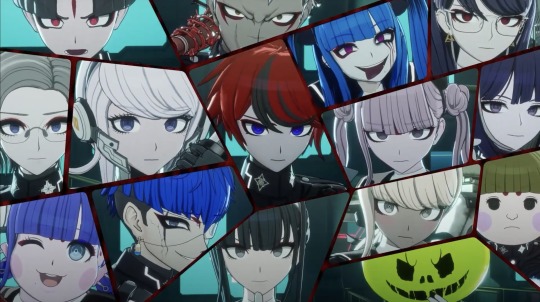


Shouma number is nine but interestingly enough it is written in upper capital Chinese Hanzi instead of Japanese Kanji. which is probably on purpose because in Japan the number nine is considered an unlucky number because the pronunciation (苦) (ku) is similar to (苦) (suffering). The association with hardship, pain and ties to bad luck/misfortune overall contributes to the negative reputation behind this number. Similar to how the number 4 similarly avoided in Japanese culture.
While in Chinese the number nine has the opposite reputation with it being associated with good luck/good fortune and can also mean long lasting and represents the maximum level of martial happiness and longevity. I just think that is a nice subtle detail in his uniform and weapon design overall with his number being nine and all.
This probably means nothing but nine or more correctly eight phases of the moon can spiritually is often associated with cycles of growth, release, and renewal. Also the number Nine is symbolically represented by change and having a very empathic and compassionate soul. In numerology the number nine is usually linked to things such as completion, idealism, and a strong desire to help others. Which mostly fits Shouma personality in terms of his ideals and morals.
Also his star/zodiac sign Pisces is often associated with compassion, empathy, creativity, imagination and strong intuition but also a deep connection to the sub conscious. But also the weaknesses of the sign is being indecisive, sensitive, prone to escapism and their own inner turmoil. And melancholy behaviours feelings of sorrow and poignance; where they would rather go through and meditate on deep emotions such as despair/sadness rather than have no feelings at all.
Overall, the zodiac sign Pisces is very emotional driven sign and I don’t think it is a coincidence that Shouma as a character is written to be very driven by his strong emotional feelings and thoughts.
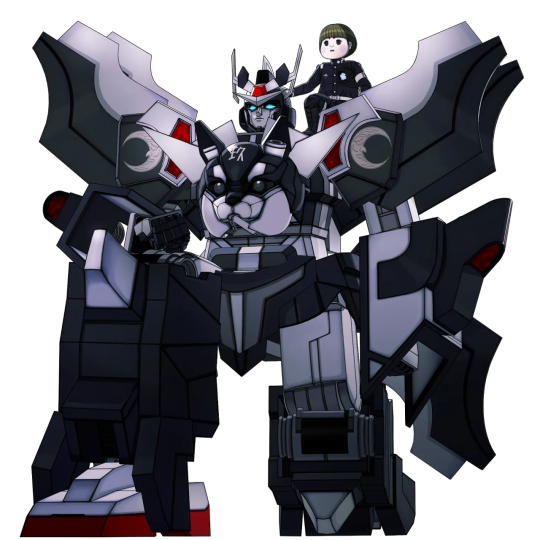

Anyway, this line of dialogue stuck out to me while playing the game demo. There seems to be a bit of a moon theme going on here? Or at the very least I think that the moon might be an important plot beat for this game story.

Which also lead to me noticing Shouma’s mecha also has some moon imagery on its design via the shoulders pads. Another interesting thing is that the chest of the mecha is designed with a Shiba Inu face notable a black one.
Shouma’s dog is probably not a literal black shiba ha ha. Although, his weapon having the chest be of the head of a black dog reminded me a bit of the Chinese mythology of the black dog called Tiangou/the heavenly dog. Which in the myth Tiangou either eats the moon or sun causing an eclipse but the moon is more notable one. Which could have inspired some design aspects to Shouma weapon perhaps.
Real quick, I will say that I haven’t looked too deeply or check to see if other characters have a subtle moon theme to their designs. Also, if you look closely on images of the other characters weapons they also have an although I will say a more subtle animal theme going on in their weapon designs as well.

Now onto his character design. First off, his backpack resembles a Kame/turtle shell get it because he’s hiding in his shell and need to slowly come out of it. Man, you gotta love the creativity Rui Komatsuzaki puts into his character designs overall.
Shouma’s boots also have a bit of a turtle-like pattern and with them being green, it looks like he has little turtle feet. His boots also partly resemble wellies, which are commonly associated with children at least in fiction giving him a childlike feel to his design. Plus they’re also outdoor boots and are usually quite popular with dog walkers as well.
Finally, his cap in terms of shape resembles either a frog, bear or hamster which adds even more to the animal theme to his overall character design.
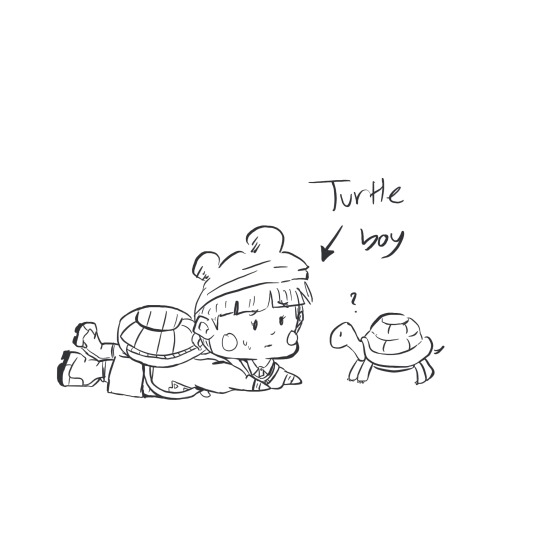
I’m honestly curious with how Shouma’s dog, which is most likely a Shiba Inu and Sirei are connected somehow and it’s also interesting how he’s the only one that didn’t technically fight. Like there has to be a reason for it right? I also think Shouma is more important than he gives himself credit for, although I may wrong who knows.

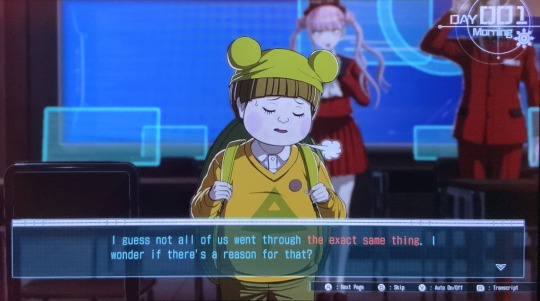
I don’t know if others have noticed this but Shouma to me seems to be a very peacemaker type of character. He doesn’t like conflict and always puts others comfort and needs first before himself a far good amount of the time. Plus, the way he talks about his dog in optional dialogue. Makes him appear to have a selfless and kind hearted soul underneath all the self esteem/self deprecation issues of course.
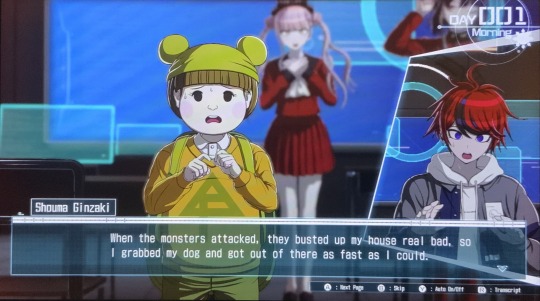
I also think Shouma appears to be pretty good at reading the room and how others might be feeling. On the rare occasion he chimes in, he has some pretty possible ideas and theories on what might be happening in the current situation. But given how many times he’s gets shot down or told he’s stupid for thinking or saying anything at all.
Which probably breaks his confidence to where he feels he shouldn’t have said anything at all. Which is why he’s just accepts it and doesn’t push against it. Because he truly believes he can never be right on something but also insists on being a peacemaker making him unable to truly take on conflict.
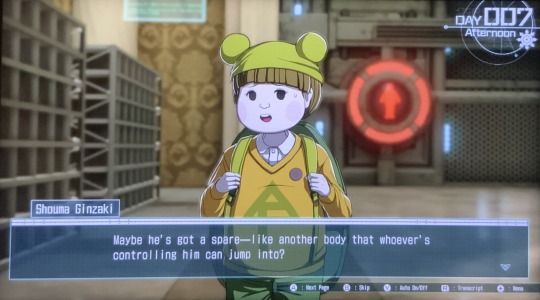
Overall, from what I’ve seen so far, Shouma seems to be a very gentle soul. Who is way too harsh on himself but I do have faith that he will develop as a person as the story progresses. It probably won’t be perfect and I don’t expect his self esteem problems to just magically go away, that takes time. Honestly, Shouma so far is very relatable to me as someone who has gone through similar hardships as a teen.
Shouma has so much potential to be such a lovely and compelling written character overall and I look forward to see what the writers have in store for him in the full game. (He’s so autistic coded to me but that could just be me projecting a little onto him ha ha…)
Lastly, gameplay wise Shouma has the potential to be pretty op as a unit depending on how his abilities and moveset functions in the gameplay mechanics.
He is a counter defender and his ability shut-in gives 1+ attack with every emery that hits him. Which could have potential to be stacked if his ability can get even stronger. Reflecting back attacks is his key, so Shouma ideally will probably excel being throw at enemies head first and focus on crowd control.
Shouma will probably work best with the more frail units. Leading the enemies onto him while doing chip damage and letting heavy hitting units dish out the big hits. He’s also will probably have good synergy with the healer/support units as well but overall. I think he will probably be one of the better units in the game due to his ability to do crowd control in a game, where crowd control is key. Also depending upon on how his ability works he could also be quite a decent boss slayer as well.
Anyway, that concludes my little slightly mentally ill ramble on him. OvO’)
#the hundred line#last defense academy#thllda#shouma ginzaki#The hundred lines last defence academy#My art at least the two original fanart pieces in this post are ha ha.#Character rambles#first impression and thoughts on a character.#I had written a bunch of notes on him all way back in early April and just now have decided to shower all of my rambles in a post. OvO’)#Anyway Shouma design is pretty neat. :3c Most of the ideas and thoughts not might be fully correct but hey that’s the fun of speculation.#Rui doesn’t get enough credit as the main artist because he is so creative and put a lot of thought and effort into his character designs.#Also I am the only one who thinks Eito doesn’t feel genuine in his niceness overall. I don’t know something just feels off about it to me.#I’m also not surprised by the fact Shouma is not well liked in general but I do believe he will be a sleeper hit character overall I feel.#I’m still patiently waiting for my copy of the game to arrive. Avoiding spoilers for the game is such agony at times.#God I can’t believe Kodaka and Uchikoshi has dragged me back. This game ahh the brainrot is real for it help.#Then again I was reading all the interviews and blogs from Japanese side quietly for this game since March so I was already in the pits.#I will probably get slightly flamed for this but come on people this boy clearly got some Teruteru dna character design wise anyway. OvO’)#Also is it just me or does Shouma feel like an Uchikoshi character at times rather a Kodaka character in terms of his vibes.#Note I am not Japanese so if I might gotten some things wrong and you’re Japanese feel free to correct me if I had made some mistakes. >v<’
27 notes
·
View notes
Text




ive had this mental image in my head for so long you dont even know
so CYN called N big brother, but I don't think we ever heard her call V or J big sister
now, it could just be that she only ever called N that. But I think it's funnier to imagine that she called N "big brother N" and V "big sister V" but J was just "J" no honorifics, nickname, or excitement. Just "J"
"Hello big brother! Hello big sister! J... Hello Tess!"
#art#murder drones#j just being j is so endlessly hilarious to me#i didnt care enough to put effort into it so you get the style i made up in the past 30 minutes#sorry this person you're gonna get a lot of notifications probably#i hope you turned off the settings on your phone#been doing my cyn impression over this for the past like week or so i forgot when i found this post#murder drones n#murder drones v#murder drones j#murder drones cyn#murder drones tessa#serial designation n#serial designation v#serial designation j#i think searches also look for tags in reblogs???? i dunno ive just been pretending i know how the site works#this is like my third time ever reblogging something bite me
932 notes
·
View notes
Text
In Thy Name - Ch.3. - Suffocation Day pt. 2.

viktorxfemale!reader a teeny tiny bit of filth, but still very much sfw. She would suffocate otherwise :') gothic AU
Reader is a highly renown linguist hired by Viktor, a paranormal investigator, for a case he cannot crack himself.
<- previous chapter MASTERLIST + SOURCES next chapter ->
word count: 5,3K
author's note: Playlist here! @rennethen and @mithrava thank you for beta-reading! And art, of course, by @cringemaster3! Translation of the poem at the bottom :v Also see how I'm keeping the chapters reasonable length? Very demure.
Cross-posted on AO3
—
It is eerie in the library. The room is covered floor to ceiling with bookshelves, tomes leather-bound and heavy but besides the obvious titles on all areas that are of Viktor’s interest there are some unexpected—little notebooks of poems, paperback and thin, worn with time, seemingly reached for more than once.
The collection is not the largest you’ve ever seen, nor the grandest, yet something about it holds you in place as you scan the shelves. Dim autumn light filters through tall, narrow windows, casting long shadows over rows of dark-stained bookcases. The air is scented with old paper, ink, and the ghost of candle smoke. A fire burns low in the hearth, its embers pulsing like a dying heartbeat, lending the space an intimacy that makes you feel as though you’ve intruded upon something secret.
You step further in, your skirts whispering against the polished wood floors. The library shows signs of frequent presence—papers stacked in uneven piles upon the desk, a forgotten quill resting atop an open ledger, ink dried mid-sentence. Books lie splayed across various surfaces, their spines cracked, their pages lined with annotations in a precise, slanted hand. Even before your gaze lands on the titles, you sense that this is no idle collection of literary indulgence; everything here has been selected with purpose.
Your fingers trail lightly over the spines, murmuring their titles under your breath. Ars Magna Lucis et Umbrae by Athanasius Kircher, Le Monde Primitif by Antoine Court de Gébelin, volumes on astronomy—Ptolemy’s Almagest, Kepler’s Harmonices Mundi, and even a Latin copy of John Dee’s Monas Hieroglyphica. The works on mathematics are no less impressive—Euler, Descartes, and an entire section dedicated to the studies of non-Euclidean geometry.
You pull a book at random, its leather cover cool beneath your fingertips. The gilded letters on the spine read De Rerum Natura, an old treatise on natural philosophy. Viktor’s interests, it seems, stretch far and wide. It’s a scholar’s collection, but not a passive one; every book you examine bears traces of his thoughts—notations in the margins, underlined passages, pages marked with scraps of paper.
Among the tomes of science and philosophy, you notice something softer: a collection of poetry. Lyrical Ballads by Wordsworth and Coleridge, Goethe’s West-östlicher Divan, a French edition of Baudelaire’s Les Fleurs du mal. You flip through the pages of one, your thumb pausing on a passage that has been marked in ink:
Quand, les yeux fermés, en un soir chaud d'automne, Je respire l'odeur de ton sein chaleureux, Je vois se dérouler des rivages heureux Qu'éblouissent les feux d'un soleil monotone.
Something in the act of his marking it makes you hesitate, feeling as though you’re glimpsing a side of him he does not often reveal. Something entirely different—curiosity perhaps—stirs your mind into wondering who is on Viktor’s mind when he reads it.
You let the book slide shut, exhaling slowly. There’s something about the house—its silence, its contradictions—that unsettles you. It’s full of missing pieces, of thoughts unfinished. Designed to keep strangers away but those who do step close enough, lure inside and trap.
Straightening, you turn towards the desk where your own work awaits. It’s time to bring your mind to the task at hand. You fix disobedient strands of hair back into your updo as you lay out the materials you gathered earlier. You examine Viktor’s translation carefully, the words from the wall written down with his precise hand.
Iměti tъ, kto vъ tьmě idetъ, ne prozъvati. Sъlovo jemu da ne dašь, i vъ noštь ne ględaj v oči jego. Vězdi on, kъto zovetъ i słyšetъ, ale ne imějęti glasa. Vъ tъmъ iměti, osъvobodi iměti.
The original Proto-Slavic text glares at you, and your eyes immediately settle on the key term: iměti. You know from your studies that iměti means “to imitate”—a verb denoting mimicry, the act of reproducing something rather than possessing it. The word feels significant, but in an unsettling way, as if it’s out of place.
Next, you focus on prozъvati—the word Viktor translated as “to call.” The more you study it, the more you find yourself caught by its peculiar form. It is a term that, in this context, goes beyond a mere vocal summoning. Prozъvati feels as if it is connected to something deeper, a way of reaching out that implies more than just speech—an invocation, perhaps, or a beckoning.
You shift your attention to ględaj. The Latin equivalent, spectare, would generally be "to look" or "to see," but this verb in Proto-Slavic carries more weight. It seems to imply a deeper form of observation, a searching gaze—not simply seeing something, but understanding it with a sense of obligation. It makes you wonder how Viktor’s translation, with its focus on avoiding meeting someone’s eyes, fits into the original context.
As your gaze drifts to sъlovo and zovetъ, you find yourself staring at the delicate balance of meaning these words might hold. Sъlovo is simple, translating directly to “word,” but there’s something about it in this particular structure that implies a weight to what is unsaid. And zovetъ—again translated as “calls” in Viktor’s version—seems to hold a different nuance. The form of the verb makes you think of summoning, but not of a voice or a language—more akin to an intangible force.
The final words, vъ tъmъ iměti, prickle your spine with pins. The phrase resists translation, slipping through your fingers as you try to grasp its meaning. The repetition of iměti is strange, its sense of imitation and mimicry now invoking something even darker. This isn’t just about one person calling another, or avoiding eyes. It’s as though the iměti is a way of bringing something into existence—or denying it.
In a fit of frustration, you lean back, rubbing your eyes. Your research has brought you closer to understanding the intent behind Viktor’s translation, but the true meaning remains elusive. The puzzle pieces don’t quite fit together.
What settles over you like cold stone is the realisation that, with what you have at hand, Viktor’s translation is, in fact, correct—and your expertise here is useless.
The usurper of he who walks in darkness must not be called. Give him no word, and in the night, do not meet his eyes. Everywhere he is, he hears when called, but he has no voice of his own. In the echo, rid the fake.
Nothing about it seems out of place—no lost sense, no hidden clue, nothing to suggest an error. You read both versions again and again, murmuring them under your breath, transposing them into Latin, Greek, and French. And yet, in every language, the meaning remains the same.
A sigh presses from the shallow part of your chest, constricted by the corset’s cruel embrace. You slump backwards in the chair, pressing your fingers to your temple. And the moment you close your eyes, something cold and dreadful unfurls within you.
You are in the library—yet you have no memory of getting here. No recollection of walking, of reaching for the door handle, of pushing open the heavy wooden wings. No moment where you crossed the threshold. You are simply... here.
The word rings between your ears like a church bell: imě. And then—nothing. Blackness, thick and suffocating, folding over you like the sea swallowing a drowning man—until, at last, it disperses into the gentle warmth of the library’s hearth.
Beyond the window, whatever feeble sun had struggled all day to pierce the clouds had long since surrendered. Now, it hovered low over the horizon, its light thin and waning, swallowed by the encroaching dusk. You glance at the clock, swallowing down the lump of disquiet that has settled in your throat. With a lip caught between your teeth, you gather your notes and march to Viktor’s study.
Your heart is a weight on your shoulder, your breath shallow as you raise a hand to knock. The sound barely has time to settle before his voice—muffled by the heavy wood—reaches you.
"Come in."
You step inside, and the warm glow of lamplight casts long shadows over the walls, stretching his silhouette behind the desk. He straightens at the sight of you, his expression soft with familiarity.
"There you are," he says, voice carrying the warmth of a fire just stoked. "It was getting late. Have you found something?"
“I—” You hesitate, pressing your notes to your chest. "Nothing. Your translation is perfect, by my standards."
"Oh," Viktor murmurs, something like a pleased hum threading through his voice. "I am flattered. Are you certain, though? Please, take a seat," he says, extending his hand to the chair facing him.
"Thank you, but I've been sitting all this time. I will gladly stretch my legs," you reply, pacing instead, your fingers tightening around the edges of your papers, your chest still tight with contraption. "I searched through whatever I could find in Greek, Latin, and French," you continue, exhaling sharply. "I have also skimmed through Slavic myths." You shake your head. "And this is so... vague. The possibilities are endless."
Viktor watches you with quiet patience, fingertips idly tapping against the desk. "Would you like to share at least one of them? I do have the time."
"Well, of course," you say, rolling your shoulders back. "Since this is undoubtedly an early form of a Slavic language, the first creature that comes to mind is Licho—or Likho, depending on the region. A one-eyed demon of misfortune, sometimes appearing as an old woman or a beggar to gain entry into homes. It offers false guidance, pretending to bring luck or wisdom, while in truth leading people to ruin. As per the usurper in your translation..."
Viktor hums, his gaze sharp with interest. "Interesting," he murmurs, though in truth, something in his chest stirs—no, it roars—his mind alight with the rare thrill of sharing thought with someone equally consumed by the subject at hand. To watch you pace, to see the way your hands carve meaning into the air, your face shifting with each thread of thought—half offered to him, half spoken into the ether—is, to him, a remarkable sight.
Were it a thought he dared to entertain, he might even say that, in this brief exchange, you had made him feel less alone.
"Also," you draw a breath through clenched teeth, shifting your weight, "Boginki. The False Mothers. Infamous for stealing babies and replacing them with changelings—sometimes pretending to be caretakers, or... well, mothers." You resume pacing, your voice gaining momentum. "There are plenty of such beings across different mythologies, but none fit exactly." You pause, glancing at him. "The do not meet his eyes fragment—why? What would happen if you did?"
Viktor folds his hands atop the parchment, contemplative. "Are you suggesting a creature that turns people to stone?"
"Something like that," you murmur. "Are you familiar with the origin of the Medusa myth?"
His brow lifts, curious. "Is there any other than the widely known?"
"It’s a mistranslation," you say, turning to face him fully. "Or rather—truth lost in layers of retelling. It’s speculated that what we now know as Medusa—who evolved from the Gorgons—was originally a male warrior with wild hair, appearing in Mesopotamian, Near Eastern, and Indo-European myth. The turning-into-stone element simply meant death, brought by the warrior or guardian, whoever he was." You halt at the edge of his desk, eyes steady on his. "It’s a long shot, isn’t it?"
You exhale, finally, and sink into the chair behind you.
Viktor leans forward, pulling the parchment closer, his eyes scanning the inked lines with renewed purpose. "It does not matter. This is exactly what I wanted from you—a fresh mind." He taps the page once. "What else are we missing?"
You lean in, reading the text upside down. Your voice drops to a murmur. "It could also be the Leshy."
Viktor glances up. "No voice of his own?"
"Precisely. Leshy is known to imitate human voices to lure people into the forest," you say, more softly now. "But in most depictions, he doesn’t speak. He only echoes."
"Fascinating," Viktor replies, leaning back. "None of this, however, gives us any clue about the breathing affliction."
"Sadly, it doesn’t," you sigh, pushing yourself to your feet. The long hours seated make it feel as though your chest can no longer hold a proper breath. You drift across the room, gaze trailing over the shelves. “There is also a thing called the Mara,” you say absently. “It’s believed she sits on people’s chests at night, stealing the breath from their lungs and filling their dreams with horror.”
You stop, hand brushing the back of a nearby chair, and release a long, weary breath. “But I really don’t know how to tie all of this together,” you murmur—defeated, yet still searching.
Around you, books and trinkets are arranged with the precision of a mind that values order—yet there are signs of frequent use: papers stacked in uneven piles, ink bottles left uncorked, a cup of tea long gone cold. Viktor watches you closely.
“It is barely your first day,” he says, voice low and thoughtful. “Nothing gets done in one day.”
You scoff under your breath, unsatisfied by the ease in his tone. One arm wrapped tightly around your midsection, the other gliding along the book spines, you scan the titles with mild distraction. Pressure begins to coil inside your ribs again, a subtle ache swelling with each shallow breath.
Then, amidst the neatly arranged oddities, your gaze catches on a deck of cards—its edges plain, the backs painted with modest, medieval designs.
Your fingers brush the stack as you speak. “Do you dabble in cartomancy as well, Mr. Velesny?”
“Occasionally. When I run out of options,” he replies, rising slowly. His steps are long as he comes toward you, and when he speaks again, his voice is barely above a murmur, warm against your shoulder. “And I thought we agreed—you should call me Viktor.”
“My apologies... Viktor,” you manage, though your voice is thin, breath trailing at the end. Your insides feel unbearably constricted, your corset biting down with every rise of your lungs. Is it the garment—or him? You can’t tell. “It’s an odd deck. I’ve never seen this type before.”
“It’s Minchiate,” he says, reaching around you to lift the deck, the closeness of him sending a fresh wave of heat to your face. “It includes additional cards. Offers deeper insight.”
He presents it to you on an open palm. “Shuffle it. Draw one.”
You hesitate, gathering the cards from his hand. “Are you certain?”
“Absolutely. Perhaps it will give us a clue—of all things.”
The weight of the deck is unexpected in your hands. The cards are slightly too large for your palms to shuffle gracefully, so you do it slowly. Once you deem it ready, you ask, “Alright then... how do I do this?”
“Cut the deck where it feels right. Pull the top card.”
Your fingers tremble as you lift the cards, the pressure in your chest intensifying. You cut the deck, drawing the top card with effort. “It says only... XI.”
“Hermit,” Viktor replies at once. “Interesting.”
“Is it telling me I’m a loner?” You attempt a smile, though your lips are dry and your vision is beginning to tunnel.
“No,” he says softly. “Traditionally, the Hermit is depicted blind, carrying a lantern. Look—” He turns to the bookshelf and pulls out a small booklet, flipping quickly through the pages. At last, he taps one with his finger. “Marseille, L’Hermite.” He tilts the book toward you, revealing a hunched old man printed in black and white, clutching a lantern, his face disturbingly grotesque. “He carries knowledge where there is none. Hope, even,” Viktor says, voice low, almost reverent.
Your voice breaks on the exhale. “Am I your hope, then?”
“You might as well be,” he says with a quiet smile, though his gaze is searching—watching the colour drain from your face.
Your breath catches—high and shallow. The bookcase in front of you feels like the only thing keeping you upright. A cold sweat breaks across your brow as black seeps into the edges of your sight. Your mouth opens, but no air reaches your lungs. Every gasp is swallowed by fabric and bone.
“It’s too tight,” Viktor murmurs, moving swiftly behind you. His voice drops into urgency. “Miss, you will faint if we don’t fix this now. Do I have your consent?”
It is by absolute necessity, he tells himself, as his fingers hover at the nape of your neck, brushing a few stray strands aside. You nod—unable to spare a breath for ‘yes’—and whatever air remains in your chest hitches when his fingertips ghost the skin just beneath your hairline.
“Dear God, why would you endure this torture?” Viktor mutters, hooking the cane over his forearm. And were he not so concerned just now, perhaps he might have caught the irony in his own words—his breath always shallow, each one measured, careful not to draw too much air into lungs that have never known ease.
His hands settle at the base of your spine, hovering just above the row of buttons that fasten the back of your bodice. You feel him hesitate—the brief pause of a man bracing himself—before his fingers begin their work.
"Who in their right mind designed this number of closures?" he mutters under his breath, his tone caught between irritation and disbelief.
His knuckles brush the fabric with each movement, slow and methodical. He works his way upward, button by button, the task made no easier by how closely they sit to one another. The silence between you is thick, broken by the soft clicks of fastenings getting undone and the occasional flutter of your breath as your lungs strain for air they still cannot fully claim.
At last, the final button slips free, and the bodice loosens at the edges, exposing the laces beneath. Viktor hesitates once more.
“This will be colder,” he murmurs, more to himself than you.
Then his fingers dip beneath the stiff outer fabric, brushing over the linen underdress that lies flush against your skin. There's no bare contact, yet the warmth of your body radiates through the thin barrier, sinking into his touch like heat into snow. His fingertips still, then resume—precise and steady, despite the way his pulse has begun to thunder at his throat.
He says nothing, but you feel him falter just slightly when the curve of his hand grazes the small of your back. Through the light linen, faint freckles are visible—soft constellations scattered across your skin. He memorises them without meaning to.
The laces loosen, one at a time, pulled free in patient sequence. The tension around your ribs begins to melt, and your shoulders drop with a trembling sigh.
When he finally begins to draw the laces back, this time more loosely, the process is slower. The cords resist the rhythm, and his hands must navigate the now-shifting fabric more carefully.
“You seem well-versed in unlacing, but not in lacing back, Viktor,” you murmur, a touch dryly, attempting to cut through the electric tension.
There’s a pause. Then—“Is that your concern now?” he replies, and when you let out a breathy chuckle, he adds, “Would it unsettle you if I said yes?”
Caught entirely off guard, you say nothing. Embarrassed—ashamed, even—you feel heat bleeding into your cheeks and scold yourself for attempting to tease a man who can clearly fight back. Noting your capitulation, Viktor only smiles to himself.
Finally, the knot is tied, the corset now sitting far less cruelly against your ribs—and at last, you can breathe. He pulls the bodice, which had slipped from your waist, back into place and begins the mundane task of fastening all the buttons.
To your utter loss, now that you’re finally able to feed your lungs with air, they refuse to cooperate—your breathing remains shallow, faltering. You startle especially when his hands reach the upper part of your back, where the only thing shielding your skin is the almost non-existent undershirt. It burns, nearly, and you are uncertain whether it’s your ears clogging with pressure or if it is, in fact, Viktor swallowing hard.
Once done, he straightens the fabric gently, then lifts his hand to smooth his palm down the length of your back—a final touch, calm and grounding.
“There. Is that better?”
You do not answer right away. You simply inhale. A true breath—full and deep, stale air spilling into your lungs without pain. It fills you so completely it feels like drowning in reverse.
“Yes,” you whisper, steadying yourself. “Thank you.”
Viktor’s hand lingers a moment longer before falling away. The silence between you shifts—not eased, but altered—recalibrated into something that hovers between tension and trust. Something very much alive. It emboldens you enough to say, “It would not unsettle me. To know that you are versed.”
You notice a smile ghosting across his lips as he lowers his gaze. Only now do you realise that perhaps he is just as flustered as you—only far better at hiding it. His cheeks are tinged with the faintest pink, and though his eyes remain half-lidded, their exact shade hidden beneath lowered lashes, you are certain his pupils are as wide as when he speaks of his revelations.
He clears his throat, a subtle but telling gesture, and places his cane back in hand with a practised movement. “The sky is clouded tonight,” he says, gesturing toward the darkened window with the tip of the handle. “But if you wish to breathe some rich air—to make up for the losses of today—I could show you the garden,” he offers, voice low, almost cautious.
You tilt your head. “Algernon mentioned night is not a good time?”
“Nonsense,” Viktor replies without hesitation. A rare sharpness edges his tone, though it fades as quickly as it came. “It’s gorgeous at night. Come.”
He doesn’t wait for your agreement. With quiet assurance, he turns and begins toward the study door, his gait measured, cane making the floorboards creak beneath his weight. You fall into step beside him, still gathering yourself, still remembering how to breathe.
The house is hushed at this hour. Every candle seems dimmed in deference to the dark, casting the corridors in a soft, amber gloom. The air grows cooler as you descend the staircase and take a turn down a hallway you haven’t yet seen—narrow, panelled in darker wood, with windows showing glimpses of the pale grounds beyond.
You pass an arched doorway and then another before he stops at a pair of tall, glass-paned doors, fogged by the moisture on the other side, framed by a narrow marble arch. He produces a key from his coat pocket and unlocks them with a soft click.
The scent reaches you first. Earth. Cold leaves. Damp moss. The faint sweetness of something still blooming despite the season.
He pushes the doors open with his shoulder and steps aside, one hand resting lightly on the frame as he motions for you to enter first.
A winter garden. Quiet and low-lit, enclosed beneath a vaulted glass roof that reflects the barest shimmer of moonlight breaking through the clouds. Ferns and climbing ivy stretch toward the light, while rows of hardy white blossoms open like stars against the deep green. The temperature inside is cool but not unpleasant—tempered by the plants, the enclosed warmth of stone and soil.
A narrow path winds through raised beds, and somewhere nearby, a slow trickle of water laps gently over stone.
Viktor follows you inside, the door clicking shut behind him. “I find this place... peaceful,” he says, his voice quiet, respectful of the stillness. “There are few things here that ask anything of me.”
You glance over at him, watching the way his hand brushes one of the broad leaves as you pass—a barely-there touch, reverent.
“It’s beautiful,” you murmur. Your voice feels more real here, less strained. “Have you... done this?”
“Yes. Once, I thought herbs and plants might bring the answer to something I was researching,” he replies, his voice gentler now, touched by memory. “They did not. But the garden remains.” He glances around the space, the faintest smile tugging at the corner of his mouth. “Everything that blooms here chooses to. Nothing is forced.”
You walk a few more steps in tandem, the air fragrant with damp leaves and faint blossoms. Your lungs slowly begin to trust the freedom they’ve been given—each breath deeper than the last, no longer catching or shallow. You pause beside a low-growing bush with narrow, silver-edged leaves, letting your fingertips brush against them.
“What was the question you were trying to answer?” you ask softly, curiosity laced with awe as you glance at him.
He exhales through his nose, not quite a sigh. “Ah... that does not matter now.” A small shrug of one shoulder. “Even though it was not found, I am grateful for this place.”
There’s something in the way he says it—no bitterness, only acceptance. You watch him a moment longer, studying how different he seems here: his shoulders looser, the lines around his mouth softened, his eyes reflective instead of watchful.
“You really are full of skills,” you murmur, half to yourself, still stunned by the strangeness and serenity of the hidden garden.
“I am full of interests. Of curiosity,” he corrects with a quiet chuckle. “Here, my skills were not much use.”
Before you can ask more, a sudden rustle from a tall fern nearby makes you flinch. Something flutters past—quick and black—and lands on a bare branch overhead with a sharp flutter of wings. It lets out a single, high-pitched squeak.
“Viktor!”
Startled, you turn to him. “A... grackle?” you ask, blinking.
He smiles with unmistakable fondness. “Yes. Meet Rio.” He gestures toward the bird, who has now begun preening one wing. “He comes and goes as he pleases, through that window there.” He motions toward a narrow, open pane set into the far wall. “Be careful what you say around him. He’s gained a reputation for using people’s words against them.”
“Viktor. Sad,” the bird croaks in a mockingly low tone, tilting its head.
“See?” Viktor murmurs, almost amused. “He will paint me pathetic before you even get the chance to know me better.”
There’s a flicker of something like vulnerability in his expression, but it passes quickly. He slips his hand into the pocket of his coat and retrieves a small metal ring, thumbing through a few keys until he unhooks one. Carefully, he places it into your open palm.
“You may come here as much as you wish,” he says, his voice low, nearly blending with the rustling leaves. “I find this place good for the mind.”
You glance down at the key resting in your palm. The cool weight of it feels symbolic, as though you’ve been let in on something secret—something close to his heart. A small part of him, entrusted to you.
Lifting your eyes to his, you find his gaze steady, amber dimmed by the faint glimpses of moonlight through the glass. You offer a quiet, sincere, “Thank you.”
The silence that follows is not uncomfortable—it hums with something unspoken. His expression shifts just slightly, something flickering behind his eyes.
“Oh, I forgot to tell you,” Viktor says, stepping back with a subtle shift in tone, practical again, though a note of softness lingers. “The Černoglav family asked for three days to prepare for our arrival.”
You nod, the name pulling your thoughts briefly back to your larger task.
“In the meantime,” he continues, “I’ve been called to another case. It might be entertaining—should you wish to accompany me.” His tone is hopeful, inviting.
“Oh?” you ask, curiosity tugging at your voice. “What supernatural aid are you bringing this time?”
He lifts his cane slightly, gesturing as though introducing the absurdity of the situation. “A family nearby is being haunted by the ghost of a vengeful horse.”
You blink, trying very hard to hold back a disbelieving smirk blooming on your face. “A vengeful... horse?”
“A stallion, precisely,” he clarifies, with deadpan seriousness. “Do not mock, Miss. They are terrified,” he adds, moving closer and pointing his fingers at you in a playful scold, cheeks hollowing with a ghost of a smile.
You press a knuckle to your lips, attempting not to laugh. “Have they tried feeding it some phantom sugar cubes?”
“That is our job,” he replies smoothly, though the corner of his eyes lift up, and a smile wrinkles his face. “What do you say?”
You pause for effect, then sigh with mock gravity. “Ah, maybe a bit of distraction will serve us well in all this. Why not.”
“Brilliant,” he says, already half-turned toward the door. “We leave tomorrow after breakfast.”
“I shall await impatiently,” you reply, taking a step to join him, when Rio’s squawk snaps both of your heads toward the source of the sound.
“Imě, imě, imě!” the bird repeats, flapping his wings menacingly on the branch before launching himself through the open window, disappearing into the night.
Viktor blinks, wide-eyed, then looks at you, equally surprised. “Forgive me, Miss, he does that sometimes. Has he startled you?” he asks, quickly recollecting himself and extending a hand for you to grasp.
The memory has already eclipsed in your mind, buried under a cairn of today’s events, when you are suddenly pulled back to both your dream and the eerie door on the first floor. You take his hand but study him carefully, and instead of answering, you ask, “What’s behind the door upstairs?”
“Oh.” Viktor’s brows draw together, taken off guard. “Nothing that should concern you. It’s something from my past, insignificant,” he attempts to dismiss you, but you do not falter.
“Are you certain it’s insignificant?” you press, squeezing his palm insistently.
“Why would you ask?” Viktor pushes back, his expression shifting to one of discomfort. His hand leaves yours, and seeing no answer, only an expectant stare, he takes a step back and straightens himself.
“If there is no justification for this, I do not feel inclined to share.” The cane twists to the floor as he turns his back to you and begins walking toward the door. “Do not raise that matter again, please,” he throws over his shoulder. “And be ready to leave in the morning, should you still wish to accompany me,” he says finally and disappears into the corridor, not giving you a chance to wish him goodnight.
Left alone in the dim garden, the air seems to shift around you, growing colder with each passing second. You hug your arms tightly around yourself, a shiver rolling down your body as the silence presses in. The question lingers in the space between your thoughts, but now there’s something more—something hidden in the shadows of the house. You wonder if the answer you’ve been seeking lies buried somewhere here, wrapped in layers of forgotten memories. The chill in your bones isn’t just from the night air; it’s a creeping unease, the sense that Viktor has closed himself off, and that something crucial remains locked away. Guilt tugs at you for startling him, for prying when perhaps you should have let it go. But the key in your hand—so small, so weighty—feels like a promise, something shared with you. You clutch it to your chest, as if it could offer some comfort, and sigh deeply. At least you can breathe again.
—
Les Fleurs du mal translation:
When, with my eyes closed, on a warm autumn evening, I breathe the scent of your warm breast, I see unfold happy shores That are dazzled by the fires of a monotonous sun.
#my writing#viktor arcane#viktor fanfic#viktor x reader#viktor x reader smut#viktor smut#viktor x f!reader#viktor x oc#arcane#arcane fanfic#ao3#ao3 fanfic#viktor nation#in thy name
106 notes
·
View notes
Text
Lifeafterdeath Ship Kid: Vidal!
Created by @sarcosticsarcomere and I, he’s a revamped version of Goth in both appearance and personality, given that they are now the son of Life as well as Reaper and Geno
Concept art for their design:

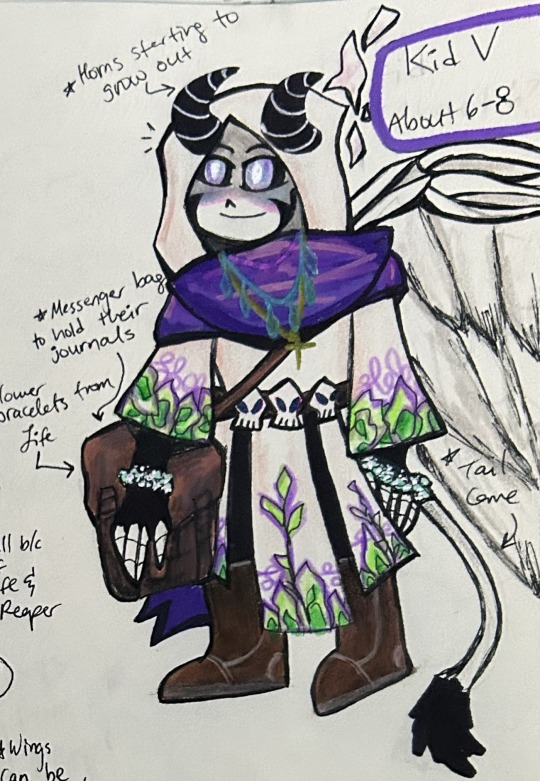
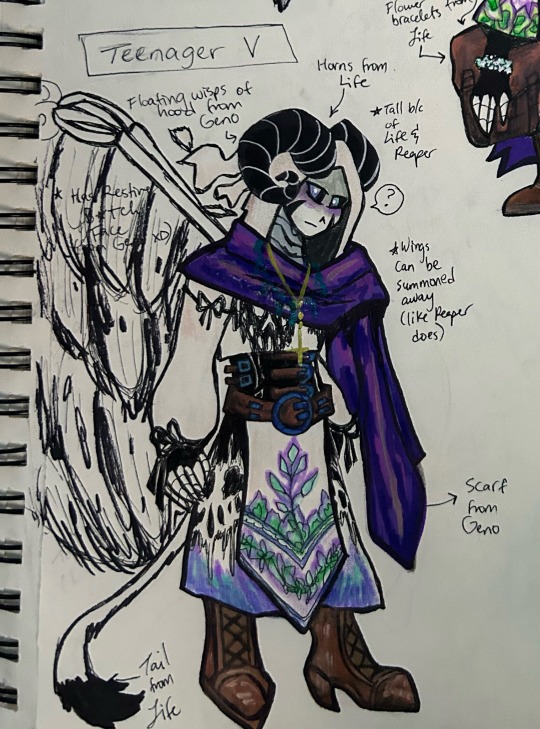
Yes I know the art is mid but if I could commission my favorite artists all the time I would be drowning in over 20K of credit card debt lmao
Nicknames: V, Vivi, or Vi
Follows True Pacifist Reapertale, making V the youngest of their siblings Frisk (aka Mercy; Life’s child), Chara (aka Faith; Reaper’s child) and Asriel (aka Hope; Life’s child)
Pronouns: Masculine, V identifies as a He/Theyby
Sexuality: Fluid
Height as a teenager: Over 6 feet tall
Personality and some background info: Vidal is a soft-spoken, socially awkward guy. Doesn’t say much, but once they open up to someone and are comfortable around them V could excitedly ramble on and on about their special interests. They had trouble making friends growing up due to being the demigod son of two prominent gods. As a result, when they first met Palette Roller and TK, they went by the name Valeria to hide their identity and befriend the other young skeletons.
Fun facts:
V can do goat blep, shift his eyelights to resemble a goat’s eyes, goat bleat, goat scream, and freeze like a goat when frightened. As a child, V adored affectionate headbonks and would play fight frequently with their siblings and parents. For their goat Mom and goat brother, it was a delightful game. For everyone else, sore foreheads were a common occurrence
When angered, V’s eyelights morph into a goat’s eyes and take on a redder shades
Around 6-8 years old their horns and tail started to appear and grow.
When Vidal’s horns and tail grew out, they became clumsy due to constant struggle with their sense of balance. They’d become frustrated and give up on walking altogether and simply float. This lead to Lifeafterdeath using child leashes to hold onto their floating son while a grumpy V pouts with their arms crossed in the air like a huffy balloon.
They share Life’s passion for botany, inherited Geno’s love for astronomy, and mimic Reaper’s gothic aesthetic. However they are terrible with plants and kill every one they try to grow much to their dismay. They also often carry around a messenger bag for their scrapbook and journals to write about and press and preserve their favorite flora into.
Reaper preens V and their siblings and occasionally V will try and preen their friends or familial figures like Epic and Dream.
Palette Roller is Vidal’s best friend since they were young babybones. They’d often hangout together and when they learn about the other’s infamous parents, empathize and soon become inseparable.
Whenever they can’t be watched by one group’s parents, they are babysat by Epic, their “Bruhncle”. V adores Epic and enjoys wearing fingerless gloves and boots as a nod to him.
Vidal’s Fashion Aesthetic
Best described as gothic cottagecore, V’s color scheme consists of primarily white and black with some blue, green, and purple. Anything that has plants, a gothic motif, or celestial theme, V will wear. Sometimes V will have jewelry decorating their horns for special occasions like birthdays or holiday celebrations. Or when they’re trying to impress their crush xD
Vidal x Palette: Canon
When Vidal develops a crush on Palette, they don’t confess their feelings because they have no idea if their best friend even feels romantic feelings, least of all towards them. They’re very close, but Vidal can’t tell if it’s platonic or romantic.
Palette knows they care deeply about V but has no idea what kind of love it is. He’s unbothered by this. After all, his parents are all in a queerplatonic/romantic relationship (Hyperinsomnia; the romantic comes from Dream and Error’s relationship) and happy and committed. As long as V is in his life and they’re best friends forever he’s happy. Palette does experience attraction and think V is hot. Unlike V, Palette grew up in queerplatonic family, so romance isn’t something Palette has particularly experience in
They start dating before they confess their feelings, confusing everyone except Palette’s family xD At first glance it appears as though Palette is aggressively friend-zoning V the entire time when it isn't his intention.
Some bonus funny screenshots regarding Palette and V from Sarco and my talks the other day:



#vidal goth sans#goth sans#vidal goth#revamped goth sans#Vidal ref#yes I know the accent on pere is wrong#stupid autocorrect 😭#crepic#lifeafterdeath
69 notes
·
View notes
Note
Your discussions on AI art have been really interesting and changed my mind on it quite a bit, so thank you for that! I don’t think I’m interested in using it, but I feel much less threatened by it in the same way. That being said, I was wondering, how you felt about AI generated creative writing: not, like AI writing in the context of garbage listicles or academic essays, but like, people who generate short stories and then submit them to contests. Do you think it’s the same sort of situation as AI art? Do you think there’s a difference in ChatGPT vs mid journey? Legitimate curiosity here! I don’t quite have an opinion on this in the same way, and I’ve seen v little from folks about creative writing in particular vs generated academic essays/articles
i think that ai generated writing is also indisputably writing but it is mostly really really fucking awful writing for the same reason that most ai art is not good art -- that the large training sets and low 'temperature' of commercially available/mass market models mean that anything produced will be the most generic version of itself. i also think that narrative writing is very very poorly suited to LLM generation because it generally requires very basic internal logic which LLMs are famously bad at (i imagine you'd have similar problems trying to create something visual like a comic that requires consistent character or location design rather than the singular images that AI art is mostly used for). i think it's going to be a very long time before we see anything good long-form from an LLM, especially because it's just not a priority for the people making them.
ultimately though i think you could absolutely do some really cool stuff with AI generated text if you had a tighter training set and let it get a bit wild with it. i've really enjoyed a lot of AI writing for being funny, especially when it was being done with tools like botnik that involve more human curation but still have the ability to completely blindside you with choices -- i unironically think the botnik collegehumour sketch is funnier than anything human-written on the channel. & i think that means it could reliably be used, with similar levels of curation, to make some stuff that feels alien, or unsettling, or etheral, or horrifying, because those are somewhat adjacent to the surreal humour i think it excels at. i could absolutely see it being used in workflows -- one of my friends told me recently, essentially, "if i'm stuck with writer's block, i ask chatgpt what should happen next, it gives me a horrible idea, and i immediately think 'that's shit, and i can do much better' and start writing again" -- which is both very funny but i think presents a great use case as a 'rubber duck'.
but yea i think that if there's anything good to be found in AI-written fiction or poetry it's not going to come from chatGPT specifically, it's going to come from some locally hosted GPT model trained on a curated set of influences -- and will have to either be kind of incoherent or heavily curated into coherence.
that said the submission of AI-written stories to short story mags & such fucking blows -- not because it's "not writing" but because it's just bad writing that's very very easy to produce (as in, 'just tell chatGPT 'write a short story'-easy) -- which ofc isn't bad in and of itself but means that the already existing phenomenon of people cynically submitting awful garbage to literary mags that doesn't even meet the submission guidelines has been magnified immensely and editors are finding it hard to keep up. i think part of believing that generative writing and art are legitimate mediums is also believing they are and should be treated as though they are separate mediums -- i don't think that there's no skill in these disciplines (like, if someone managed to make writing with chatGPT that wasnt unreadably bad, i would be very fucking impressed!) but they're deeply different skills to the traditional artforms and so imo should be in general judged, presented, published etc. separately.
213 notes
·
View notes
Note
if comfortable, would you recommend any books? i’d be so interested in the ones you favor
Took me some time to come up with an answer since I'm pretty much omnivorous about literature and, imo, it is more difficult to decide on favorite books rather than on movies. Many books moved me and left an impression despite not being overall "my thing", like Doctor Zhivago by B. Pasternak. No idea why I reread it. I don't even like it much. Somehow I do not recall what it was about either. On the other hand there's V. Nabokov's Real Life of Sebastian Knight. Quite amusing in Russian with the translator's and Nabokov's notes on said translation (It was the first novel by the author entirely in eng).
So allow me to mostly list what I found memorable or at least remember via my bookshelf.
Apparently, I have a weakness for the doctor's diary genre. Veresaev's Memoirs of a Physician and Bulgakov's A Young Doctor's Notebook with Morphine go there. All three are autobiographical and describe interesting insights into contemporary life and relations between superstition and medicine. Bulgakov, however, should be seen as a guy who's bitter about monarchy losing.
Big fan of Dostoyevsky obviously. Humiliated and Insulted and Demons.
I fell into Medieval literature hellhole around my graduation year. Chrétien de Troyes, Érec et Énide. Or pretty much anything by him. People didn't change much since then by the way. H. Walpole the Castle of Otranto is about what people of XVIIIth century believed Medieval times to be. Malory is to blame. Malory is for when you have too much free time. Just like him. He apparently was in prison when he wrote le Morte d'Arthur. Despite the grandiose flair it is a very frivolous retelling of vulgates. Malory was a Lancelot fanboy and made sure he's the way he wants him to be. Again, I do not forgive Galehaut's erasure. Prithee, how was his best boy Lancelot introduced to Guinevere?
Florian Illies, 1913 and 1939 cycles(?) can give you have a good grasp on the scale of events and how close were different historical figures and their relationships. Also a quite pleasant starting point for history of arts of 20th century if you feel intimidated by all names and dates. Around there I got my liking for T. Mann's work.
J. Cocteau's Diary of an Unknown is likely the book I'd call the most close to my heart, but do not expect much. It is a pleasantly written memoir by a man of arts. Easy to read and light. Both are a positive and negative aspects. In a way it's shallow. I wish to know if that is because of the author's views and personality.
A special addition is Shakespeare's Richard III with Volovich's illustrations. A beautiful book. Probably what I'd consider the best reading and design for the play. I'd recommend to look up S. Brodsky's artworks for Romeo and Juliet too. A good book sometimes is about the design too.
I hope something on the list would catch your attention and help you discover something new!
20 notes
·
View notes
Text

Some of us Murdlers have ships we ship outside the oxymorons. For me, that ship (well, one of them, I have a couple others) is Eggplant and Olive. (Yes, I know, a heterosexual ship, how scandalous :V) I think they’d bond over shared hatred of their boss (see: Murdle Jr., and that’s all I can say because I’ve spoiled enough of that book as is :P)
Also, first pass at designs for both of them! Couldn’t be bothered to properly color it, though :P Yes, they both have eyebags. And messy hair. TekCo characters, to me, need to give the impression of being exhausted and generally unhappy to be here. It’s a vibes thing :P
I realize how lazy this art is, but hey, I drew it, so I might as well share it XD
#art#fanart#lily’s art#murdle#executive eggplant#executive assistant olive#i don’t have a ship name for them yet#maybe one day :P#also one day i’ll be able to draw fingers properly#today is not that day :P
13 notes
·
View notes
Text
RPG Read-through: .dungeon//remastered
For a while on Twitter, I've been doing read-through threads where I post my thoughts as I'm reading through a game for the first time. I recently did the same with Snow's .dungeon//remastered, a TTRPG where you are players logging in to a dead/dying MMO and exploring the digital fantasy world. I'm adapting those thoughts here for a proper Tumblr post! Enjoy!
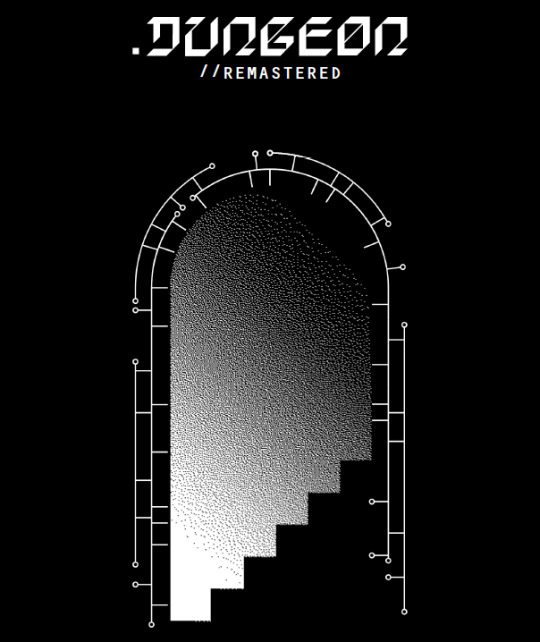
First up, credits! Good folks who do good work in my experience. Also, we get the first of what seems to be a common through-line here that I enjoy: an online fandom bent to this all being a sort of GameFAQ style guide for an in-universe game.
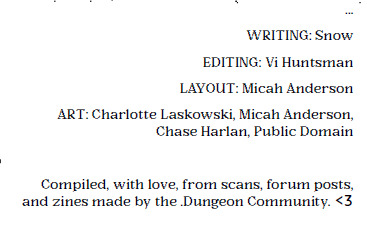
My initial impression from most of the interior spreads I've seen just flipping through it is that I really love the style and layout. I think black and white layouts are underrated generally, but it really pops here with the pixelated text/symbols and the old school GUIs.
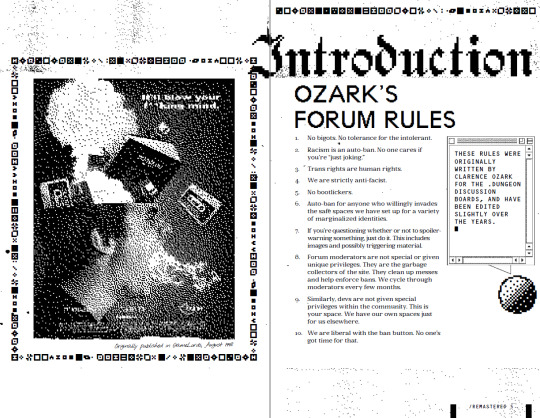
It's interesting to have these kind of "no bigotry" rules you see in many games couched within an in-universe framing. I think this more personal angle actually makes them land better for me than they typically do in games.
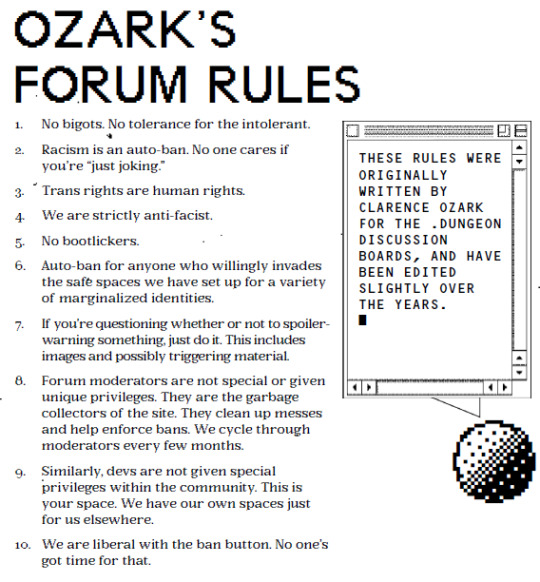
Of course, the author is still powerless to stop the players (just like with any instance of these rules, and all game rules in general tbh) BUT this is worldbuilding too, and it gives me a greater sense for the kind of in-universe fandom that's risen up around .dungeon.
Similarly, here's the game's unique version of safety tools - an in-game help menu that reworks things like lines/veils, x-card and more into the game world itself. I really like this.
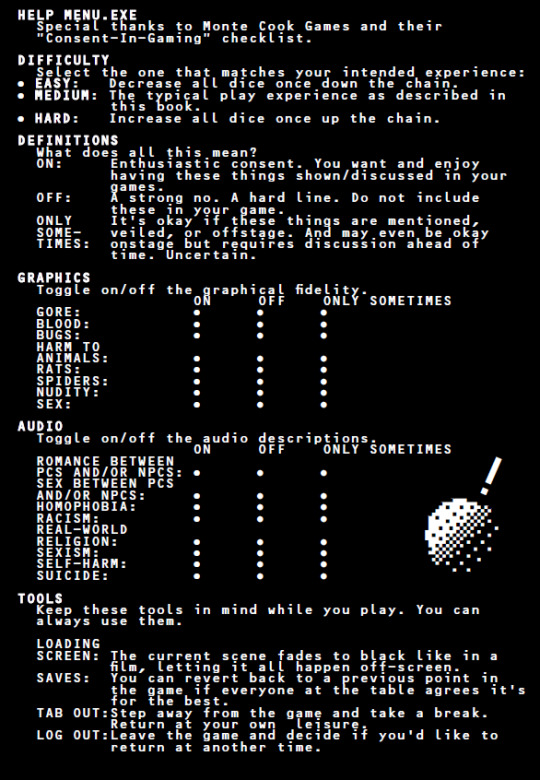
Once again, the art in this is just great. I love the Fez-like runes/symbols. My ARG brain wants to know if there's a hidden message here.

I was surprised it was jumping right into the starter adventure, Tutorial Town, but I quickly found out that this is character creation AND a starting area/adventure all wrapped into one, video game-style, and that's so cool.
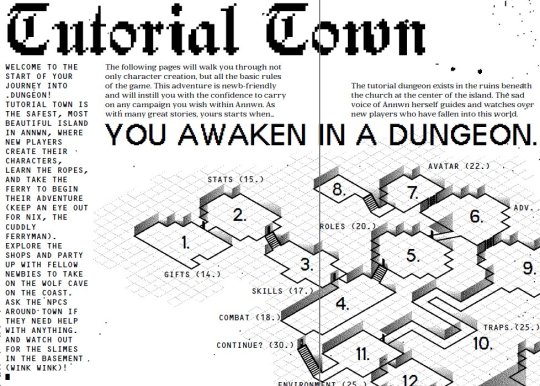
Each room of the starting area introduces a step of character creation. It's interesting that stats are based on real-world (not you the player at the table real-world but your PC at the "real-world" computer playing the game) ability. Your game knowledge, response time, etc.
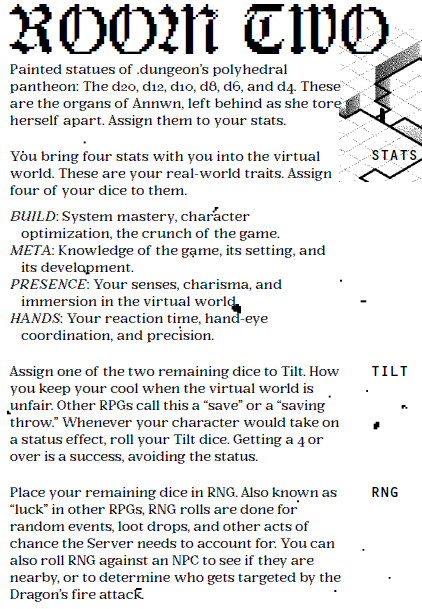
As a long time Dota player, I also just really enjoy that the saving throw-like stat here is TILT. I have tilted many times and known many of my teammates to tilt regularly. Just fun to see that phrasing in a TTRPG.
There's more of the in-universe real-world player here than I expected coming in. Definitely has some really intriguing potential. I do wonder though if the intent is to be playing a "real-world" level character or if you are "playing" as yourself at that layer. Both would work.
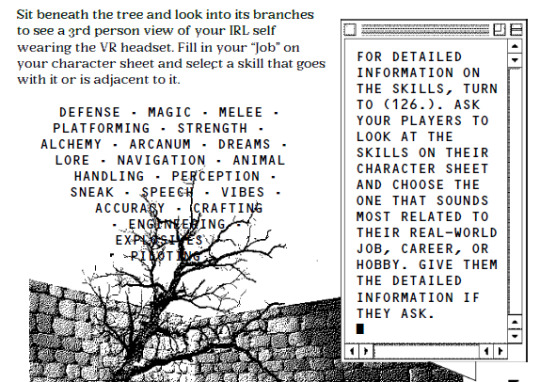
Monster statblocks. Easy to parse and straightforward to run as the GM (tho at time the layout does have one two many things laid on top of one another that can make them hard to read at first glance - like where "GOBLIN" is here):
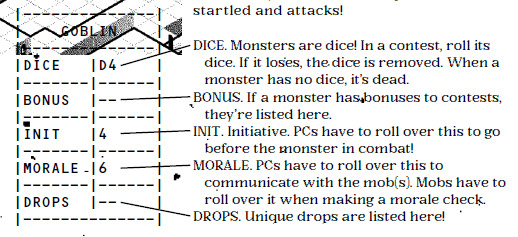
Health here is SYNC, and it's shared across the whole party - I'm interested to see how that full mechanic plays out and how it may affect play.

Reaction rolls. I'm surprised to see them given the video game setting, cus mobs in MMOs just always attack you. I've gone back and forth on it with my video game-inspired TTRPG. Don't think it's a bad choice, just one that means the game world is more than a usual video game.
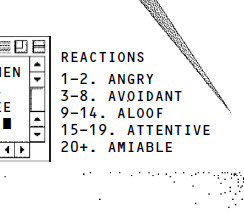
So you have your real-world level Job (based on your characters' out of game job) and your in-game "Role" which follow the classic "holy trinity" of MMO design:
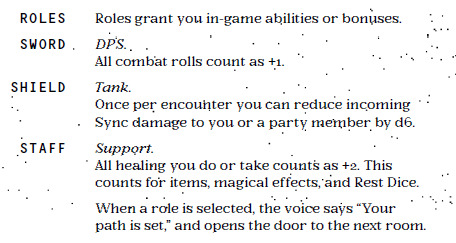
PCs and monsters can team up to attack and can forego damage for stunts - potentially fun/interesting moments happening from that. Monsters deal dmg to SYNC but only per type is interesting, means a crowd of one-enemy is more a long trickle of damage than an overwhelming burst.
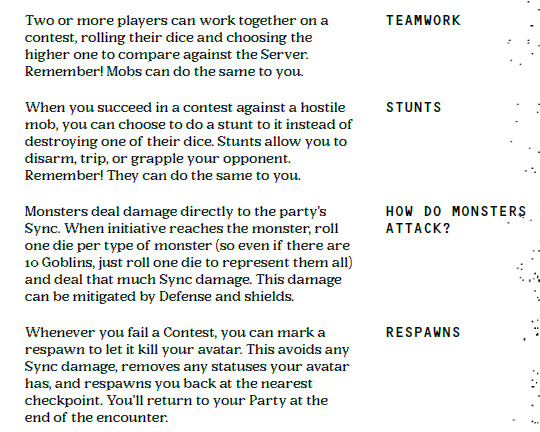
Not knowing the ramifications of SYNC damage yet, I'm not sure what the Risk v Reward looks like for Respawns but it's intriguing. Letting your avatar die to keep the party in a stronger position overall (but being able to re-join after a fight) is definitely unique.
This is another fun room (and I like that other than saying late 90s/early 2000s it leaves appearance options open). I am not sure where to find the starting origins tho (they aren't on this spread and there's no page reference). Sadly, the PDF isn't bookmarked either, it seems.
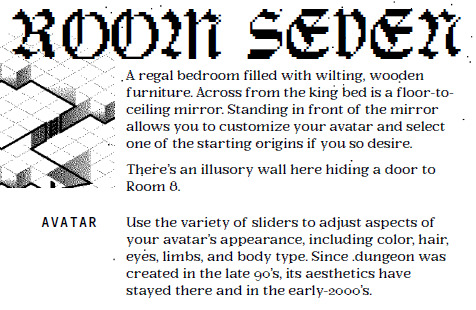
This feels like a smart roadblock to place in player's paths early on. It's unlikely they'll have a lockpick at this point so really, it's about getting players into that creative mindset. What is in the room for you to exploit? What gear do you have you can use in a new way?
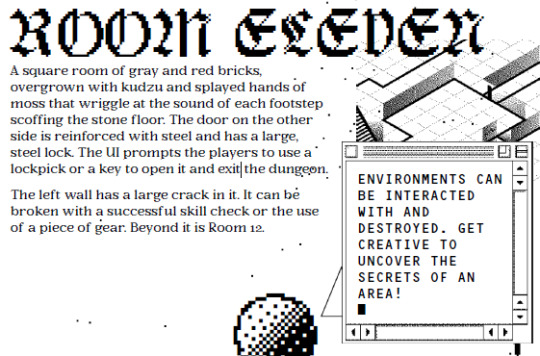
Might seem basic, especially to the OSR-experienced out there, but you'd be surprised how many players don't have experience with thinking more freeformly about the game in this way. No fault to them, most trad games condition you to use your PC's abilities/skills as a menu.
Another cool interaction between the layers of the game here (tho I do wish they all played more off of something more than just the tarot card being in the real-world layer). Still wondering if most folks play as themselves or as a real-world level PC.
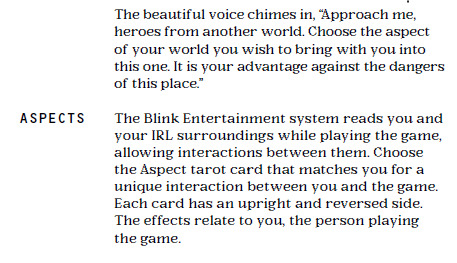
This is interesting. I wonder if there is going to be a real-world layer to play or if this is meant to be the amount your party can heal between sessions of play (like when the actual real you stops playing in actual real life - this meta layer stuff is tricky to communicate).

I like this - a very short and sweet travel system.
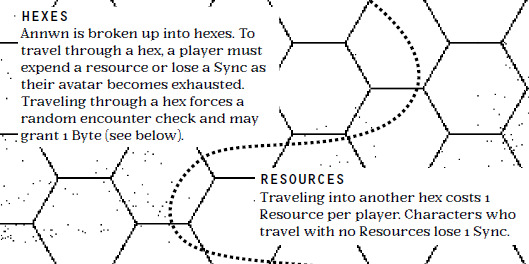
I continue to love this art. Also, this tease here around dual-wielding requiring the discovery of new Roles out in the game world somewhere first is really enticing (I added the highlighter there btw).
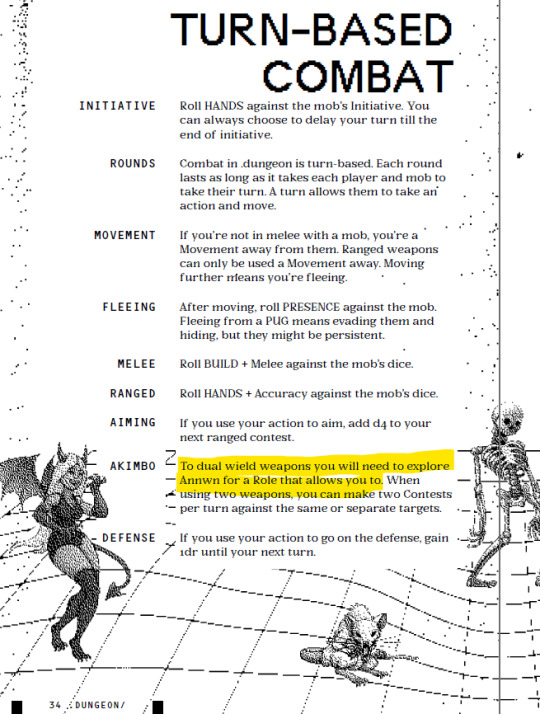
This is fun - there are both in-game NPCs and PUGs which are other real-world players' in-game avatars. That extra layer to those types of NPCs is really fun and them running the gamut of fully out-of-character chatting to being hardcore RPers is fun to consider.
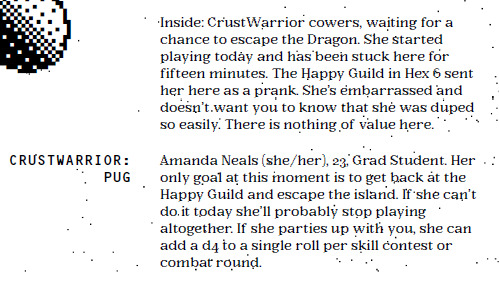
Whenever it leans into the digital world aspects, I'm super into it. Very much my kinda thing. I do wonder though how often players can swap their Roles. I don't believe I've seen that said yet - my inclination would be once on the fly (like Final Fantasy's Job systems).
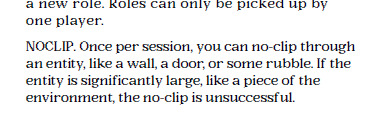
And if these various layers weren't enough, .dungeon also features in-game collectible cards that are sort of enchantments and buffs. I wonder if my real-world level character can spend real money to buy Bytes to buy more packs from a merchant in town? lol
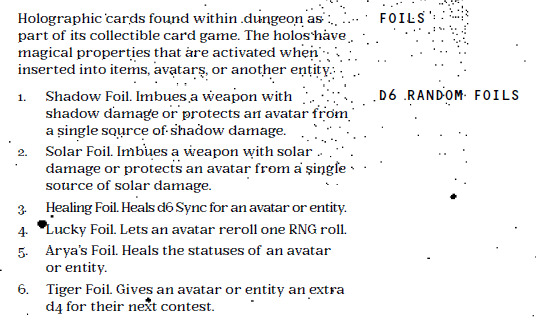
I won't spoil/detail too many more of these but these kind of fun (and common to video games but rarely seen when thinking of the world of a game or the intended way to play) moments are really appealing. Also, this game has Goons in it. Oh no.
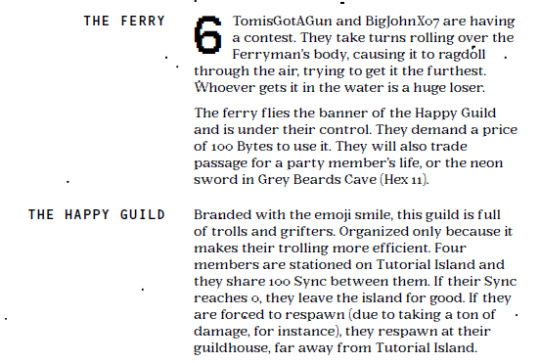
Now I'm thinking the intention is the "real-world" level of play should be the real actual you, the person playing .dungeon the TTRPG (as opposed to a real-world level character still within the fiction of the game) since stuff like this would be tricky to track. Cool item!

Tutorial Island is cool, a good blend of char creation, intro to what the game is, and just a fun adventure with a session or more of play to it. I'd have to run/play this to really see but I find the Sync being tied to essentially your real-world session length interesting.
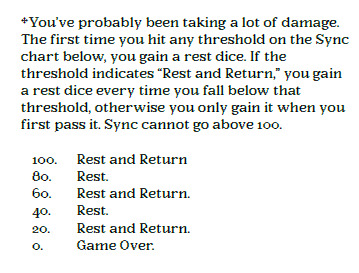
This stuff is cool and leans into that meta/fan-level play that only comes out of these big community-driven games, both MMOs but also things like Dark Souls.

A lot of these kind of possible secrets come as comments in the text, possibly just to inspire the GM and to get players interested in ways that the table can build out on their own over time. So far, I don't see some of the more esoteric secrets to be laid out (which I like).
The rest of the book, as far as I've seen, is lots of resources, gear tables, monsters, etc. to build out the game after player's leave Tutorial Island. The game world here has that anything goes Final Fantasy bent to it. There's swords & wagons, but laser guns & skateboards too.
The setting here is also explicitly queer (mostly seen so far in the "real-world" PUGs) and includes things like sex workers and other elements that it maybe could not have had but that would certainly lessen the richness of its world, the fandom presented throughout, etc.
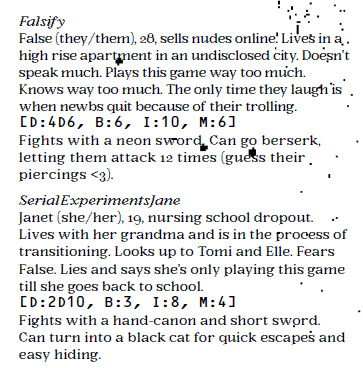
The spellcasting uses the in-game money as mana points essentially. That's a cool way to limit spellcasting and motivate player's, especially spellcasters, to get out there and make some $$$.
Okay, here's the real-world explanation I was waiting for (after the in-game gear lists and such). This is cool - it's fun to have a real-life layer to this and to have the game's world support that sort of dropping in and out, doing things outside of a full party session, etc.
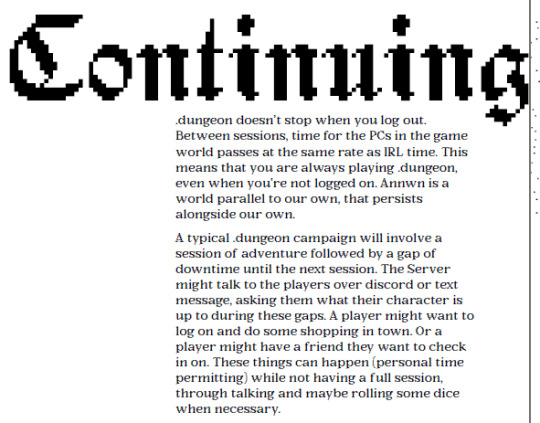
I know a lot of folks do this with ongoing campaigns anyway, but this is one of those fun things to include here to build that in as an expectation in play. You have your raid nights with friends and you have your little solo sessions after work where you sell your loot.
Now, the rest is a nice collection of random dungeon, NPC, settlement, hexfill tables and more. Everything you'd expect from an OSR-like ruleset but occasionally with some fun added meta-layers.
Players getting a quest from an in-game Moderator and then being able to become a Mod themselves is a really fun idea and something I could envision becoming a long-term goal for one or more players at a table. The threat of encountering an Admin is scary as well!
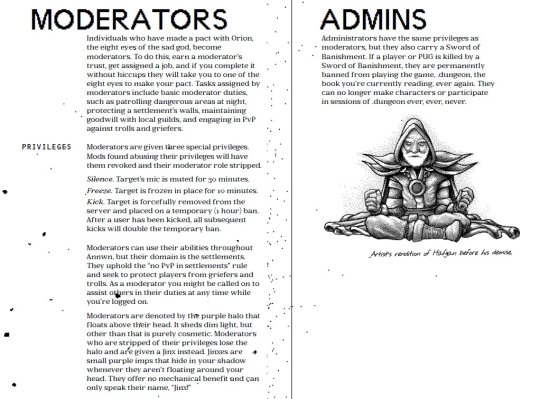
To finish it up, we've got a cool AASCII-style character sheet, complete with MingLiU-ExtB font (my beloved)!
And that's .dungeon//remastered! I really enjoyed reading this, and I think it has a strong core that's really enhanced by its real-world interaction layer. Gonna put this on "Play Soon" list. There are some smart rules in particular I'll likely steal for a future project.
.dungeon//remastered is available digitally NOW with, I believe, physical copies coming soon. I backed the Kickstarter to get this digital version. CHECK IT OUT HERE!
181 notes
·
View notes
Text
Can't get Murder Drones out of my head. Almost like some eldritch code has taken root inside my brain. It's probably fine.
Anyway, headcanons for what the murder trio were before Tessa got them:
J was almost certainly in some corporate position. I like to think she was involved in marketing, since she has all those buzzwords ingrained in her lexicon. Maybe they even had her working with graphic design with her art skills. I also imagine she kinda hates corporate structure. "Bootlicker J" jokes aside, I can't imagine even she would have fun as a (literal) corporate slave, and she definitely enjoys freely speaking her mind: not something that flies very well in corporate and marketing contexts. Maybe she got dumped during some convoluted office politics, maybe she was dumped due to random downsizing, who knows.
N's a bit trickier. We see a lot of dexterity and showmanship from him in the manor. He's quite flashy with the glassware at a few points. He also likes drawing, but is lacking in technical skill, especially compared to J. He's also quite personable and friendly, and also seems to truly admire J in some capacity. As a bonus, Cyn mimics a lot of N's mannerisms, and one of her defining traits is her acting, even specifically playing at "improv" while rebuilding J. Therefore, I think N was in theater/entertainment.
He wasn't necessarily an actor himself: still a robot slave after all. But he likely assisted with a lot of setup. Rehearsals, testing stunts, watching over pets/kids (whether those of actors or actors themselves), etc. He enjoys fancy costumes as well, and he's pretty genre aware. He's probably had his fair share of experience with horror movies/stories. Maybe he got dumped pissing off the wrong famous person, maybe some stunt went wrong and they didn't want to bother repairing him, maybe they just wanted the newest model.
V is tough to decide. She seems to enjoy fighting the most out of all of them, but none of them are really slouches in combat, so I don't think that says much about her past. We don't see much of her in the manor, but the impression she gives is a bit more shy and demure. We see her playing chess in the credits, but one hobby doesn't mean much on its own, especially since chess is a common game to put on computers: probably all of them have chess programs built-in.
With that little to go off of, and her tendency to both act out in outrageous ways and keep herself closed-off, I'm thinking she was probably a menial worker beforehand. Minimal freedom, in a position where she'd best keep her head down. Follow the rules closely in order to keep what little she has. "Do your job and I leave you and N alone" was probably a pretty good deal to V because it was as good or better than her previous work arrangements.
Could be a lot of jobs like that for a robo-slave. But let's have fun with it and extrapolate from her usage of "narc" and her apparent desensitization to violence: she was used by a criminal organization for clean-up duty, and got dumped after being confiscated by authorities.
42 notes
·
View notes
Text


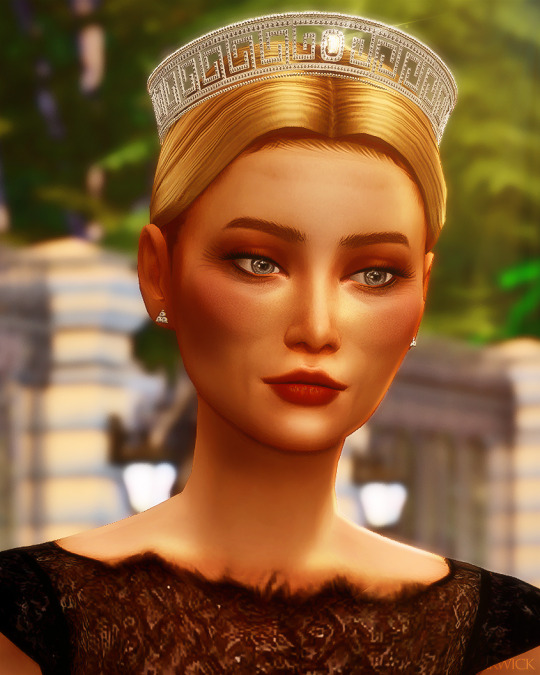

Sunderland's Royal Jewel Vault (18/∞) ♛
↬ Countess Wynn's Meander Tiara
The majority of the tiaras in the Sunderlandian collection were inherited through members of King Louis V's family, mainly previous queens Matilda Mary, Anne, and Katherine. This meander tiara however represents the current Wariwcks' French heritage, as it belonged to Queen Irene's mother, Marguerite Wynn. Countess Wynn was born in 1914 as Marguerite Delphine Lucie Chevrier. She was the eldest of four children born to industrialist Phillipe Édouard Chervrier (1880 - 1950) and his El Salvadoran wife, Consuelo Romana Gomez (1892 - 1979). Margurite's family claims ancestry from both French and Spanish nobility, although the bulk of their impressive fortune was derived from Phillipe's ceramics factory in the south of France. Much of Margurite's early life was disrupted by the First World War, during which the Chevriers settled in Mexico City with Consuelo's sister. Following the war, Marguerite flourished in high Parisian society, becoming well-versed in the arts and fluent in several languages, including English and Spanish. Expected to marry into the French aristocracy, Marguerite made waves by instead marrying John Wynn (1911 - 1973), a career soldier from Sunderland whose great family had fallen on hard times following the deaths of John's three older brothers in the war. When the couple met in 1931, John was on a mindless trek across Europe, in search of a wealthy bride. Despite their differing backgrounds, Marguerite was smitten by John's optimism and good humour. The pair married a year later, with John even converting to Catholicism to appease Marguerite's parents. Their wedding was held at the Chapel of the Palace of Versailles, one of the last grand society affairs of interwar Paris. The tiara, which featured a Greek key design punctuated by a central emerald-cut yellow diamond, was among Marguarite's wedding gifts. The jewel is ambiguous in origin but is agreed to be an early twentieth-century creation, likely from Cartier. It became a useful tool in Margurite's arsenal as she erupted in Sunderland as one of the country's wealthiest society ladies. Pearlie, as she became known, was noted to be arrogant, intelligent, and ravishing. Pearlie is more "royal" than the rest of us combined. She drenches herself in jewels as if she were the ghost of the last Tsarina. — Queen Katherine, 1970
The Countess owned the tiara until 1968, when she gave it to her youngest daughter, Lady Irene, also as a wedding present. Irene's marriage to the future King Louis V was Pearlie's greatest life achievement and she became increasingly boastful. Maman Wynn, as she was called by the press and public, was known to meddle in royal affairs, especially the personal lives of her daughter and son-in-law. By the early 1980s, she was on bad terms with both. Irene was never seen wearing her mother's tiara, but she kept it in her own personal possession for almost thirty years. In 1997, Irene continued the tradition by gifting the tiara to her only daughter, Princess Jacqueline, ahead of her wedding to Lawrence Belmont. The wedding was coincidently the last public appearance of the old Countess Wynn. She died peacefully at Chester Palace the same winter. Since then, Jacqueline has worn the tiara regularly at state functions and in official portraits. It's among the princess's most cherished pieces.
The Countess Wynn wears the tiara in a portrait, circa October 1943, eight years before the birth of her youngest daughter, Queen Irene
HRH Princess Jacqueline wears the tiara while attending a gala dinner & dance in July 2026
#warwick.jewels#✨#ch: irene#ch: jacqueline#ts4#ts4 story#ts4 royal#ts4 storytelling#ts4 edit#ts4 royal legacy#ts4 legacy#ts4 royalty#ts4 monarchy#ts4 screenshots#warwick.extras
61 notes
·
View notes
Note
Any thoughts on AKI in SF6?
I haven't had a chance to play the game yet and I might do a more thorough look into the newcomers after I do sit through World Tour, but yeah I got some AKI thoughts. Holy shit what a design. Top 15-20 in the series, it is one hell of a different thing to watch it animated by the character's personality and moveset and vibe. We expected some FANG-isms, some Juri-isms, but certainly not that. We expected a cold, even generic assassin, not someone who merrily treats the penal code like a list of chores.
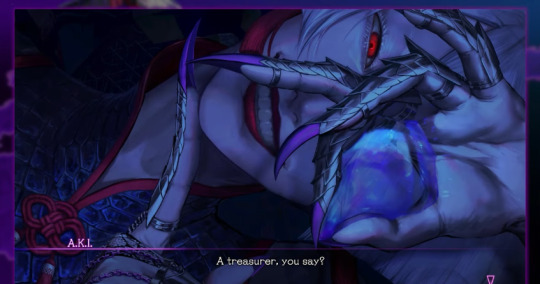
It was pretty funny seeing the reaction to her develop from "oh she's FANG's apprentice, okay I guess, not sure anyone was asking for that", to "is she the new Juri, she's got a really similar vibe", to "holy shit Juri's got NOTHING on her". In reaction to her popularity, SF6 had been doing a lot of great character work on Juri that, while making her much more developed and entertaining as a character (cringe failgirl Juri was such a revelation) and dramatically more interesting as a person, also really limits the extent to which she can be a straight-up villain anymore. Much like how FANG was designed to fill the void left by Sagat, AKI here crashed the scene to fill the void left by Juri, and so she gets to be not just completely 100% horrible (where as Juri is like, 70-80% horrible), but also SCARY in a way Juri never could be. She gets so, so much out of not being designed for sex appeal and coolness first and foremost, she's like the D'Vorah to Juri's Mileena.
She's a horrible, predatory character, and much like Marisa, I don't think she would have been allowed at all to exist the way she does had she debuted prior (you just know they would have not given her those sick ass pants or given her a different haircut or a cleavage window or something stupid like that). The development team for V repeteadly stated that there were ideas for a new assassin apprentice character related to Gen thrown around and that some of those made their way into FANG and Seth, and AKI is the end result of that very long refinement process. She's the resident freakshow character in the tradition started by Blanka and Dhalsim, and she's the outrageous over-the-top counterpoint to the more traditional martial arts like Chun-Li or even Jamie (much like Adon, or Necro). She's the understudy of the kung fu assassin villain, and in a way akin to Menat she's the young new apprentice of a prior character who acts as a stand-in for that character on the roster and driven to prove her worth before said character, while also being a modern do-over of said character.
(And for the record I actually like FANG quite a bit, a lot more than most of the other V characters. He played like garbage and his execution was lacking and couldn't make up for a terrible first impression in the fanbase, but the design and character and concept I thought were very solid and I'm glad AKI shows they didn't give up on it but took steps to improve on it, I'm glad to see him again in 6).
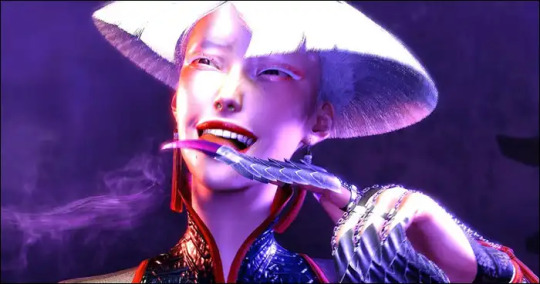
She breaks new ground for the series by leaning strongly into a horror wraith vibe no other character had before, and she's the Street Fighter equivalent to characters like Voldo, a horrible contortionist slasher villain who doesn't fight you so much as she just passionately and exquisitely butchers you while getting off on it. Her moves are incredible, superbly characterized, she feels vicious and oppressive to watch but still hits that note on FANG's where the playstyle is meant to be tricky but overspecialized and beatable at close range. And while she's designed to be a much more explicitly serious and deadly-looking character than FANG, they even give her goofy little flourishes like blowing bubbles shaped like FANG (and getting pissed if you pop them), his propensity for bird-like arms flapping, and an uncharacteristically childish victory dance akin to Chun-Li's.
She is as cadaverous as Juri is tempestuous, openly referring to herself as a ghost, and when she isn't losing her shit in contorting fits of laughter over success, she has a remarkably chill, upbeat disposition when spouting horrible things to the protagonist or fake poisoning them for laughs. She has an incredibly distinct personality more so than any especially developed inner life, and that's kinda the point: that she has wholly and completely sublimated herself to her role as FANG's tool, by choice and intent of her own, and that's part of why she's a real deal villain.
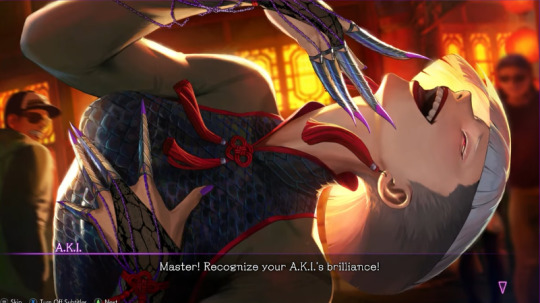
She was raised by him, she likes what he likes, she is obsessed with everything he is and has done and will do, hates everyone that isn't him, considers him her master and teacher and father and husband all in one, and her romantic fixation and love for him is meant to be deeply disturbing in every way imaginable (and only not a total dealbreaker for me because FANG in no way reciprocates or encourages it or is able to do so, even AKI understands as much), and that they may eventually have to kill each other doesn't deter her one bit.
Despite those surface similarities, there is quite a lot that sets AKI apart from Juri, chief of those being that Juri was victimized by Shadaloo and in response fashioned herself into an instrument of vengeance and turned monstrous as a result, where as AKI actively chose her life and chose being molded by someone else, running away from home and following FANG every step of the way without any regret. Even FANG himself had little choice in his own life, kidnapped as a child and forced to partake in horrible training under which every day could be his last, raised to value nothing but survival at all costs.
Perhaps this in itself is the strength that FANG saw in AKI, that she gets to choose and does so with far greater intent than even himself. That she's someone who could fully understand the horribleness of the Nguuhao methods and lifestyle and want for that and nothing else, to consciously partake in such grueling torture of mind and body and lovingly decide that she can't get enough of it.
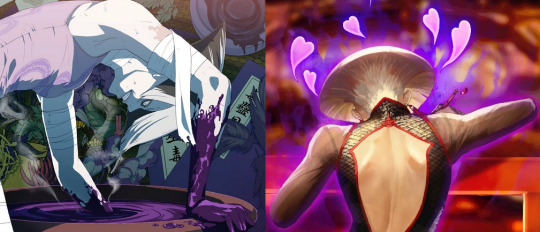
And in itself this pairs interestingly with the very idea of giving FANG a dedicated protege sidekick, a character beat that the series has come back to again and again, and takes on an entirely different tone here. I think a lot of what makes AKI's obsession interesting to me in a way these usually aren't, is not just because it's creepy, but because it's ultimately sad and pathetic, and parallels FANG's own craven worship of Bison. It's such a great dynamic, a miserable cycle perpetuated by miserable people caught on the wrong side of that glorification of self-improvement, inner strength and the great heroes and masters who can pass it onto others that the series uses so frequently, and it makes AKI even greater as a character for it: because now we have a true dark mirror for the driving motivation of many of our characters. We have our fucked-up toxic counterpart to every Sakura, Mika, Menat, and Sean out there.
She sees him as he saw Bison and more, and the fact that she is much more threatening and overtly competent and scary than FANG is offset by the fact that worshipping Bison is a wholly different thing than worshipping, y'know, FANG. We comprehend, on some level, FANG's worship, because M.Bison is supposed to be, at minimum, a cool imposing megavillain we're meant to like on some level, which is certainly not true for FANG. SF6 has been very clear on that, that even though he's been given a much slicker outfit, and is keeping a low profile to plot from behind the scenes, this is still very much FANG, every bit the conniving, petty control freak from before.
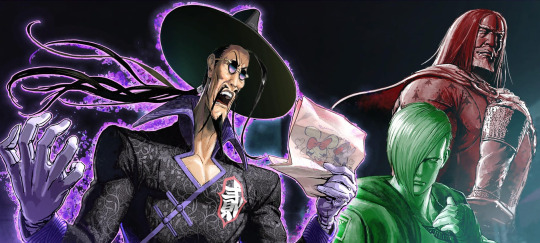
AKI is a cool, hypercompetent death machine able to scare the pants off the main villain, and she labors desperately day and night, to the point of crying if she fails, to meet the approval of a ridiculous, pathetic man who, no matter how deceptively cunning or dangerous he may be, is only cool to her. Much of why I think FANG worked and was necessary in the first place was because he was designed around the vacuum left by the Four Kings and to contrast them, as what kind of man would it take to work himself ragged running Bison's schemes and being unfailingly loyal to him and Shadaloo, opposite Vega and Balrog's sporadic barely-there alliances and Sagat's outright betrayal. We needed an anti-Sagat, a proper bastard of a Number 2 to run the show in secret. And AKI adds a lot of poignancy to that in that she is much of what FANG can't be, even as she wants nothing more than to be like him.
It's one thing to have somebody who really looks up to and makes an effort to imitate the cool and impressive and heroic World Warriors, or someone influenced by imposing villains like Balrog or Sagat but ultimately decides to carve their own path. It's another thing entirely for maybe THE most obsessive protege character in the series, someone who actively has no identity outside of servitude to her master, to revolve around FANG, the dastardly bird man, who made his debut in a story by hunting down and melting an innocent woman, and grossly and animastically licking her ashen remains off his fingers. What kind of person would decide that this sickening, vile creep is deserving of worship and following until the ends of the Earth?
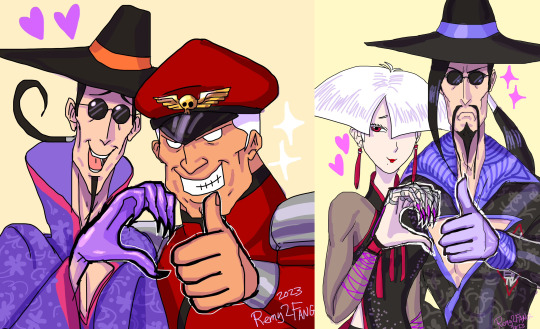
(art by @remy2fang)
Well, maybe the same kind of person who would consciously look at the likes of M.Bison in the first place, someone they intuitively understand "will reign death on all living beings", and upends their life on the spot towards becoming that man's eternal servant. Someone who seeks self-fulfillment through no other means than the pursuit of strength and knowledge as tools to subjugate others and appease their master. The darkest corruption of the master-student dynamic that defines so much of the series. You couldn't ask for anything more fitting, for the poison specialists.
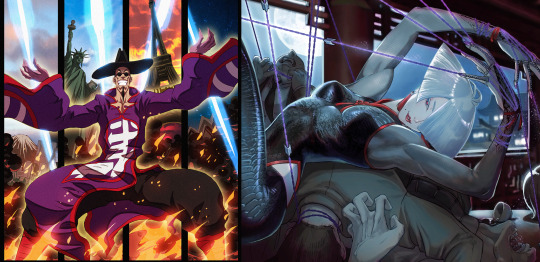
#replies tag#street fighter#fighting games#capcom#a.k.i.#f.a.n.g#aki street fighter#aki sf6#fang#sf6#street fighter 6
166 notes
·
View notes
Text
Your Journey Ends: A Parting Retrospective on Dragon Age (Part Six)
VI. Apotheosis
At a glance, Dragon Age: Inquisition is deeply flawed. The open world, while wide and vibrant, lacks direction in its quest design, with no clear distinction between which quests are rewarding or interesting amid a sea of chores. Skipping the open world entirely, however, robs the player of vital character interactions, lore tidbits, atmosphere, and overall makes the game feel too brief. Thus, there is a problem of not knowing which quests are worth spending your time on, and how much. It doesn’t help that mounts are virtually useless for traversing these vast regions. The war table operations present interesting quests with compelling decision-making opportunities, but their timed nature stifles them, gutting their potential. Combat has shifted even more toward real-time action, and the tactical macros are more limited than ever. Even in the otherwise excellent main story, issues arise. Namely, the main villain loses all semblance of menace after the first encounter with him.
With all of that said, you might wonder why Dragon Age: Inquisition is my favorite game in the series, why it’s one of my favorite games of all time, why I’ve logged almost 500 hours in it across multiple playthroughs, and why it’s my main impetus for writing this essay. The answer is complicated, and has as much to do with my own state of mind at the time that it came out as it does with the game’s intrinsic qualities.
But first, I want to address some of the previous criticisms. Frankly, none of those things bothered me. Inquisition released in 2014, before the open world fatigue hit. Back then, only really big and prestigious titles had huge, lavishly detailed worlds to explore. It also came out a year before The Witcher 3: Wild Hunt (2015), which would set a higher standard for open world interactivity and immersive quest design. As such, playing Inquisition on release never felt subpar to me – the world was breathtaking, and it allowed you to delve into the realm of Thedas more substantially than ever. It offered a sense of freedom akin to The Elder Scrolls V: Skyrim (2011), but accompanied it with better writing and characterization. Since the standard of open world gameplay has raised substantially in the intervening years, Inquisition’s foray might not be as impressive to modern players, but it was so easy to get hooked on it at the time.
Combat, too, never irked me – though I also never cared too much for the combat in either Origins or DA2. I think there’s a satisfying flow to Inquisition’s battles that rewards both proper builds and real-time mechanical mastery. I know I’m in the minority, but I honestly like the emphasis on magical barriers, warrior guard generation, and rechargeable potions over healing spells and inventory stockpiling. Not to say the latter is bad, but I think the former works well with how Inquisition integrates its encounters into exploration. Plus, you can run as a knight-enchanter and cleave through enemies with a lightsaber.
But it’s in the aesthetic, artistic, and character departments that Inquisition truly shines. I think the series found its ideal tone here. It’s lighter, more hopeful than those of Origins and DA2, but not at the expense of nuance or maturity. After what I considered the overbearing edginess of the second installment – not to mention the suffocating grimness of Mass Effect 3 (2012) – Inquisition’s earnest and optimistic outlook appealed to me. I also think this is where the series’s art direction peaked. Origins presents a realistic, immersive world, but one that’s also drab and lacking in distinctness. DA2 went for a more stylized, exaggerated look to everything. Inquisition gravitates more toward the realistic proportions and shading of Origins, but spices up some of the designs to reflect the opulence of the Orlesian setting, as well as injecting much more color into the world. This, too, was a welcome sight in 2014, as we were finally escaping the curse of games at large looking gray, brown, and muddy. The diversity of Inquisition’s biomes also acted as a much needed reprieve from Dragon Age 2’s endless reiteration of the same dungeons.
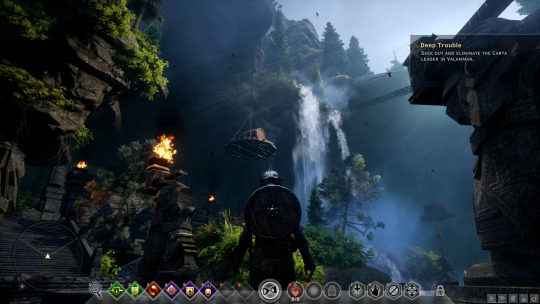
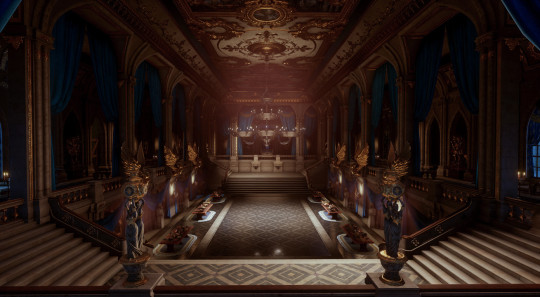
Inquisition boasts my favorite cast of the entire series. The player has twelve main disciples (not exactly subtle, in a game about faith), and all of them have unique silhouettes that set them apart, without anyone looking too over-the-top like Isabela or out-of-place like Fenris. Their personalities are just as distinct, and all loaded with hidden depth that can be teased out. Banter sessions are fantastically entertaining and often display conflicts of ideals that give the world texture (without ever making me question why these people are working together).
I never tallied up and compared the total number of choices between DA2 and Inquisition against each other, but I always felt like I had more influence over the story of the latter. The player can choose the race of their avatar again, with the addition of qunari added to the standard selection of human, elf, and dwarf. The mage/templar choice in the first act influences a variety of aspects going forward, including three pairs of mutually exclusive boss encounters, different sub-villains, and variations on the epilogue slides. The ending that decides who gets inducted as the new Divine and what policies they implement also depends on a medley of choices made throughout the game, rather than a single critical moment. You also get to choose who rules Orlais from a set of five options, the status of the Grey Wardens in Orlais, and even the fate of Hawke. Not to mention the judgments that the Inquisitor makes from their throne, where humbled and defeated NPCs face trial and punishment at the player’s mercy.
All this contributes to an awesome sense of power, in stark contrast to the previous game. Indeed, Inquisition’s illusion of power is intoxicating. There’s an inherent coolness in managing an entire organization, deploying troops and moving mountains at the player’s whim, and recruiting NPCs to populate your personal castle and serve your cause. Exploring the open world and seeing fortresses the Inquisition’s conquered, towns under its protection, or soldiers delivering you treasure out in the field – it all generates this palpable sense of authority that makes roleplaying as a (reluctant) messiah more real and gratifying. “Power” is such an important word for Inquisition that it’s literally used as a currency for the war table operations.
The other operative word is “faith.” In addition to its religious themes, which we’ll touch on soon, Inquisition seems to reward players’ faith for sticking with the series to this point – especially regarding how it carries over past decisions in interesting ways. We finally follow up on Morrigan and her potential child, as well as Alistair, Hawke, and tons of small, personally crafted references and cameos. More importantly, it answers some the major mysteries that the series has lingered on, assuring the audience that it is, in fact, going somewhere with its overarching story. We learn truths about red lyrium, Flemeth, the Blight, the enigmatic Titans, and the elusive Dread Wolf. Inquisition reinvigorated my interest in the lore of Dragon Age after I thought I had given up. In many ways, it felt like the sequel I wanted after Origins.
Beyond these appeals, faith and power both play critical roles in the game’s themes and the individual arcs of its major characters. And these concepts do not go uncriticized within the narrative itself.
Full article: https://planckstorytime.wordpress.com/2025/03/29/your-journey-ends-a-parting-retrospective-on-dragon-age/
#planckstorytime#writing#analysis#essay#dragon age#dragon age inquisition#dragon age origins#dragon age 2#dragon age the veilguard#datv critical#the inquisitor#the warden#hawke#solavellan#trick weekes#sheryl chee#bioware#solas#dai
9 notes
·
View notes
Note
Big fan of your Junkrat and RoadHog art, and your style in general. I wanna ask how you got your art style to be like how it is? (I'm working hard to be a character designer and can't help but gush over pretty art like yours)
hey ! thanks a lot, really appreciate it. that's a tough question because i've been drawing since i'm 12 (and am now 34) and even earlier and it's hard to break it down to specifics. i think the style i'm currently showing also just really manifested over the last 4 or 5 years. but everything beforehand helped to forge that style. in the end it's a combination out of everything i like in art (over the top cartoony expressions, strong expressions in general, a certain flow with the lineart, kind of a visceral feeling for bodies?? etc) and it grew over the years, after gushing over other artists' art that have similar traits, sometimes really enforcing these things by sitting down and trying to imitate them.
i know this is always a little unsatisfactory as an answer, but always remember, a style absolutely takes time, it takes impressions (surround yourself with INPUT, doesn't have to be art, can be music, films, photographs, people etc), it usually develops on itself (style finds YOU, not the other way around, UNLESS you enforce it, and i never tried it that way because i am lazy, but i think this video sums it up pretty good https://www.youtube.com/watch?v=SLfH9yOGs3o) and it grows with inspiration. it's also absolutely normal to vary in style all the time, so yeah. hope this helped a bit?? i'm really bad with these topics since i've only shortly tried to pursue art and design as a career and the rest is my hobby... and i've just been drawing for the most of it. just until recently i started doing studies, so you see, i never really worked on a style, at least not deliberatly.
73 notes
·
View notes
Note
Any thoughts on Wuthering Waves?
People constantly glaze it and claim it's better than Genshin but recently it's gone into harem stuff.
people hype that game up as better than Genshin because the skimpy dressed female characters tits bounce when they breathe lol. I’m just exaggerating but whenever I see someone saying this it’s the same person saying the fanservice in Genshin is “dead” and they’re all “wearing burqas” which is insane, not to mention offensive of course, that game isn’t like FGO or Snowbreak tier but they have ugly skimpy gacha girl outfits. like come on. but I’ve seen this sentiment down to the exact language used by different people in a lot of places, gachagaming, wuwa & other popular gacha subreddits, instagram comments, YouTube comments, twitter. Enough & with enough frequency to make me consider that as a factor. personally I find the art direction bland and when I tried playing it I wished the fighting didn’t feel so floaty, but they obviously have extremely talented animators working on it, so I can see if you liked that type of combat it would be fun to play and a spectacle to watch. but I think the combat itself is more comparable to HI3 than Genshin. Anyway for real there’s QoL factors and aspects of it being a newly created game that will be better than Genshin, the models & NPCs having more detail, playstyle, the more realistic looking world etc, that people will also like a lot more. i think since the rumored (or confirmed now?) rewrite it was always going to lean hard on the “harem stuff.” they seem to pivot hard and change things majorly based on their main audience (Chinese male) reaction. this isn’t unusual for gacha of course but the extent that they change their own story and content kind of gave me pause when I read about it. like they released a male character on launch but literally cut his banner short for the sexy female character. if you watch the original CBT those girls the MC first meets are extremely wary of him, even pulling a gun on him. It wasn’t anything great but it created some interesting tension for the start of the game. the CN reaction was so extremely negative to this that it was completely changed to all the girls being polite and impressed with your skills. Now every female character is completely obsessed with the MC to an extreme degree, everything in their life actually happened because pre-amnesia MC was a super powerful leader, 10 close ups of the girl’s v-tuber face, 20 of her tits, etc, that’s usually how the character quests go. I saw CN fans have been extremely angry and complaining that Genshin’s MC is just a “camera” watching the story unfold before them, I guess this is WuWa’s answer to that lol. If you want to experience this watch someone play through that character Shorekeeper’s story. imo you could tell the direction this game would go just based on how they designed the female MC compared to the male MC. if this is the audience they want to keep and retain, we’ll see what happens in the coming years 🤔 I didn’t play PGR that much or follow their news so I’m not as familiar with what Kuro’s marketing and publishing style is
14 notes
·
View notes
Text
Reflections on The CLAMP Universe and Cardcaptor Sakura
The goal of this piece is to critique CLAMP’s narrative techniques and character design, with extensive criticisms of Tsubasa and xxxHOLiC, but with no intent to demean the characters themselves.
This is an informal essay that initially aimed to explore why Tsubasa Reservoir Chronicle "damaged" Cardcaptor Sakura and address the complicated emotions of Yue fans, along with the overlooked role of Yue as the Judge. My initial motivation was to critique Ohkawa’s treatment of Yue, but as I delved deeper, the complexity of the discussion grew, making it difficult to settle on a suitable title.
[Reader Notice]
This article is approximately 4,500 words, with logical connections between sections. Please avoid skimming if you intend to engage fully with my arguments.
The purpose here is to discuss the literary techniques and character development within these works. Although there is extensive criticism of Tsubasa Reservoir Chronicle and xxxHOLiC, this does not imply a disparagement of any character. If you hold a different perspective, I welcome well-reasoned discussion. I will not respond to overtly aggressive comments; please avoid bringing in fandom drama.
The original text was in Chinese and published in 2022. I used ChatGPT for the translation and did an initial proofread myself.
I have a lot to say about Clow’s characterization and CLAMP’s failure in portraying him, but I haven’t included it here. English-speaking readers who are interested in discussing it are welcome to message me privately.
[Contents]
I. General Overview of CLAMP II. On Scriptwriting Flaws in CLAMP, with Tsubasa Reservoir Chronicle and xxxHOLiC as Examples III. Cardcaptor Sakura: A Beautiful Yet Unrealistic World
IV. The Forced “Crossover” of CCS, Tsubasa Reservoir Chronicle, and xxxHOLiC V. The Tragedy of Yue and the Inevitable Character Deterioration in Clear Card
VI. Reflections on Clow/Yue Fan Interpretations
[Note] Unless otherwise specified, "CCS" refers to Cardcaptor Sakura as a series, excluding the Clear Card arc. Tsubasa Reservoir Chronicle (TRC)refers primarily to the manga version.
I. General Overview of CLAMP
Despite its popularity, CLAMP is particularly notable for its commercial acumen rather than other artistic strengths. Their success is evident in their keen market insight and adaptability across varied genres, especially in crafting small details (like character and artistic designs). However, they appear weaker when it comes to larger conceptual settings (such as worldbuilding). Although CLAMP’s illustrations are relatively impressive—particularly with art books being frequently published—their overall impact within manga itself is not as prominent. This is especially apparent in action scenes (like fight sequences), which often lack the necessary sense of motion and impact.
In terms of scriptwriting, CLAMP’s style could be described as “aesthetic-driven,” yet the content often veers into melodrama, with plots that lack logic and coherence. The themes they present can sometimes feel troubling: their works tend to emphasize "fatalism," placing excessive focus on an idealized notion of "love" that can feel unrealistic. Although CLAMP’s works are widely recognized, their scriptwriting level does not always match the acclaim they receive.
The following sections will delve further into the issues in their scriptwriting.
II. On Scriptwriting Flaws in CLAMP, with Tsubasa Reservoir Chronicle and xxxHOLiC as Examples The scripts for CLAMP’s works are primarily written by Ohkawa Nanase, hereafter referred to as "Ohkawa."
Many fans regard TRC as a masterpiece, claiming it must be read in tandem with xxxHOLiC to truly appreciate its depth. I strongly disagree with this viewpoint. Below, I’ll refute several key aspects that TRC fans often praise:
The time loop involving the Real and Clone versions of Syaoran and Sakura at the end of TRC.
The intricate timeline with Real Syaoran, Clone Syaoran, Real Sakura, and Clone Sakura is frequently lauded as "mind-bending" and as something that "feels ingenious once fully grasped." In reality, though, this couldn’t be further from the truth! The author clearly lacks the expertise to handle time loop narratives effectively, leading to a storyline that is confusing and difficult to follow. In TRC, Ohkawa uncomfortably relies on ideas of "fate" and "inevitability" to explain the time loop, such as when Real Syaoran steps into Yuuko's shop, setting off a chain of events. However, even if readers accept these ideas, once they unravel the plot, they encounter paradoxes typical in time-travel fiction—especially issues related to the grandfather paradox, which the author leaves inadequately resolved. Moreover, the concept of a time loop itself doesn’t require multiple versions of Syaoran and Sakura to complicate the storyline—this intriguing concept could be fully explored with just a single character.
In the ACGN (Anime, Comics, Games, Novels) world, time loop storylines generally lack the craftsmanship seen in genuine science fiction, and there’s a stark difference between them. (Even Steins;Gate, often considered a “masterpiece,” handles this somewhat clumsily.) Instead, I would recommend Isaac Asimov's The End of Eternity, which showcases meticulous planning, genius in handling paradoxes, and an exploration of philosophical and sociological themes.
(Side note: TRC has numerous bugs, and here’s an interesting one related to CCS: Before Clow Reed warped time and made his error, the King of Clow Country was Fujitaka. However, after Clow’s mistake, Fujitaka splits into Fujitaka and Eriol in the Cardcaptor Sakura world. So, where did Fujitaka, King of Clow Country, come from in earlier parallel worlds? Thus, TRC was awkwardly linked with CCS solely for commercial gain, which I’ll explore in depth in Section Four.)
The CLAMP-style "Sense of Fate" and "Angst" In other works focused on themes of fate, some authors manage to express it with the resonance of Greek mythology or Shakespearean tragedy, while others rely on plot conveniences. I must reiterate that fate is a challenging theme in the ACGN realm, and CLAMP’s works—particularly TRC and xxxHOLiC, where fate is often central—are notably flawed in this regard. By comparison, I feel Puella Magi Madoka Magica addresses this theme relatively well.
TRC constantly emphasizes "costs." In Fullmetal Alchemist, another ACGN work, the concept of “equivalent exchange” reflects the author’s world-building efforts, with fair exchange rules—for instance, achieving immortality requires the sacrifice of countless lives. However, TRC’s world-building is practically nonexistent, with no explanation of the exchange methods or rules. How does Yuuko's shop operate? What can be used as payment? What kind of payment achieves what kind of wish? Ultimately, everything is decided by Yuuko herself. And yet, this “cost” is central to much of the story's angst, such as Clone Syaoran’s connection to Sakura and Real Syaoran’s memories with Watanuki.
In xxxHOLiC, although Yuuko does not return, TRC introduces clones, time rewinds, and space-time distortions while still insisting “the dead cannot return.” This approach feels highly contrived. xxxHOLiC asserts that “there is no coincidence, only inevitability. Every cause has an effect.” This overly deterministic view, combined with weak plot logic, makes Watanuki’s “poignant waiting” in a butterfly dream sequence feel hollow, lacking emotional depth.
Stories that effectively handle fate as a tragic theme often move the plot and create a tragic hero through a series of reasonable yet inevitable events, even if they involve supernatural elements like mythology or religious undertones. A modern example would be Tolkien’s The Children of Húrin, where, under a curse, the protagonist unwittingly kills his closest friend, unknowingly commits incest, and brings misfortune to anyone who draws near, unable to escape the curse. Each event is plausible, whether attributed to the curse or his own character traits.
In contrast, CLAMP’s unexplained ideas of "inevitability, cause and effect, fate, cost," etc., feel more like lazy ways to resolve conflicts and advance the plot, exposing the creators’ limitations. CLAMP-style “angst” largely boils down to “because the author says so,” requiring readers to suspend logical thought entirely, fully accepting the premise, and simply reveling in the “beauty of fate” and the “angst” it supposedly brings. This approach seems best suited to an audience in their angst-filled teenage years, and can be termed “manufactured angst.” For readers who prioritize narrative consistency and well-built worlds, such a plot structure is not only unconvincing but also confusing and awkward.
The Interconnections and Plot Twists between and within TRC and xxxHOLiC When it comes to the interconnected references and callbacks in CLAMP’s works, I can’t provide an in-depth analysis as I haven’t thoroughly read all of them. However, when a story’s core and the author’s skill fall short, no amount of layered references, plot callbacks, or parallels in visuals and character design can add real depth; it all ends up feeling shallow, lacking in substance. To draw an imperfect comparison, the first five chapters of Dream of the Red Chamber, especially the prophetic verses, were crafted by Cao Xueqin. If Gao E had continued the work from there, would the overall effect still be as mesmerizing?
The fatal flaw of Ohkawa’s signature twists lies in the fact that the early foreshadowing and groundwork are nowhere near enough to support the later “stunning plot twists,” which often feel forced and contrived. Creating these twists isn’t difficult because the text can be intentionally ambiguous and open to various interpretations. For example, inserting a few seemingly irrelevant, vague lines into the dialogue leaves space to “explain” (or even improvise) later. They might even deliberately create ambiguous lines and scenes, allowing for a range of explanations further down the line.
Take, for instance, when Fei-Wang tells Real Syaoran, “You’re just like me” (in an exaggeratedly dramatic scene). Most readers might think this suggests they share a common goal, like resurrecting the dead. Yet Ohkawa’s later explanation could be that Real Syaoran is like Watanuki, who is like Clow, who is then like Fei-Wang, making Real Syaoran like Fei-Wang. However, this explanation lacks any logical foundation. The context, preceding events, and the story’s world-building all fall short of supporting such a forced interpretation. Yet this is then presented as “reasonable” in the story’s development, which doesn’t count as proper foreshadowing. Even so, these kinds of setups still earn admiration from many readers, which is honestly quite amusing.
(Side note: In Cardcaptor Sakura, Sakura once told Yue, “You and Yukito-san are so similar,” a line that Yue himself didn’t agree with. However, should Ohkawa decide to “expand” on this line in the Clear Card arc, it might trigger a similar shock effect.)
In summary, the values and narrative techniques in CLAMP’s works often seem rather peculiar, fully revealing Ohkawa’s limitations as a creator (even though she once audited literature courses at a prestigious university, her work’s results speak for themselves). CLAMP’s audience adores TRC and xxxHOLiC, while readers who don’t appreciate this style often struggle to continue and may even doubt the work’s quality. Unfortunately — or perhaps fortunately — I find myself in the latter category.
III. Cardcaptor Sakura: A Beautiful Yet Unrealistic World
Without the nostalgia of childhood, CCS is essentially a typical, idealized Mary Sue-style shoujo manga. It heavily emphasizes gentleness and a “magical allure,” which can come across as somewhat hollow. Even the progressive themes it’s praised for today, like “love transcending social status, identity, and gender,” aren’t unique to this work alone. During the golden age of Japanese manga, CCS wasn’t an especially standout work.
Like CLAMP’s other works, the CCS manga lacks real-world logic. However, as an idealized shojo manga, its conflicts are far less intense than those in other CLAMP works, so the absence of realism doesn’t feel as jarring. CCS presents a beautiful, dreamlike world (though this idealization is taken to an extreme in the character of Yue, the Judge; under close scrutiny, it’s doubtful this perfect world could hold up — more on this in Section Six). For this reason, CCS doesn’t quite qualify as an exceptional fairy tale. A true fairy tale should resonate with all ages, and telling a simple, pure, beautiful story well is no small feat. In the ACGN (Anime, Comics, Games, Novels) sphere, I consider Ghibli’s Castle in the Sky to represent the pinnacle of this genre. The Ghibli world might feel plausible, but CCS’s world feels purely fantastical. Healing, gentle stories also have layers, and when the setting and plot logic feel more realistic, the gentleness and healing resonate more deeply. Even so, CCS remains CLAMP’s best work in this genre and may even be their only truly “pure” story. Due to CCS’s theme, the work almost entirely avoids the script flaws discussed in Section Two, with none of the dark, glamorous style, twisted, chaotic plotlines, or subtly angsty themes that characterize many other CLAMP works.
About 80% of CCS’s immense success can be credited to its anime adaptation. (Though I haven’t researched the manga’s sales or the anime’s viewership ratings, this is my subjective conclusion.) Compared to the manga, the anime’s storyline is more well-rounded (such as the addition of Syaoran competing for the cards and Li Meiling’s character). The characters are portrayed in more depth, addressing many of the manga’s script issues and removing some elements difficult to accept in reality (such as Sasaki Rika’s teacher-student relationship). The anime feels more grounded than the manga, enhancing its healing effect without feeling hollow. Furthermore, the anime’s art direction is more refined and diverse (with additional outfit changes and Clow Card designs). Combined with factors like the peak of Japanese animation’s expansion at the time, these aspects contributed to CCS’s widespread popularity.
In summary, CCS is CLAMP’s only purely sweet shojo manga, suitable for all ages and wholesome, and this is what most CCS fans love about it. This fanbase doesn’t entirely overlap with the audience for CLAMP’s other works.
IV. The Forced “Crossover” Between CCS, Tsubasa Reservoir Chronicle, and xxxHOLiC
In discussions surrounding Cardcaptor Sakura (CCS), it’s common to see people recommending Tsubasa: Reservoir Chronicle (TRC) and xxxHOLiC, claiming that these works "explain" certain plot points in CCS. I strongly disagree with this viewpoint. I believe that if you enjoy the healing, wholesome themes of CCS, along with elements like magical girls and costumes, it’s best to avoid watching TRC and xxxHOLiC, and there’s no need to delve into CLAMP’s other works either.
The crossover between CCS and TRC/xxxHOLiC fundamentally disrupts CCS’s independent charm for two main reasons:
Firstly, CCS is entirely different in genre from other representative CLAMP works, especially TRC, as discussed in Section Three.
Secondly, using character names from CCS in TRC and xxxHOLiC is purely a commercial tactic, designed to draw attention by tapping into CCS’s popularity. Beyond shared names and appearances, there’s essentially no thematic or plot-based connection between TRC/xxxHOLiC and CCS.
Since TRC appears to have a closer link to CCS, I’ll primarily use it as an example for analysis.
So, what is TRC really about?
[Plot Overview]
In summary: The first half consists of episodic dimension-hopping stories, with Syaoran traveling through various parallel worlds to collect feathers to save Sakura. Most characters in these episodic arcs are from past CLAMP works. The latter half focuses on unveiling the truth (with a slew of Ohkawa-style twists) and the final confrontation with the antagonist, though this section’s handling of time loops is poorly executed, as previously discussed.
In detail: At the moment of Yuuko’s death, Clow Reed briefly wishes she could "open her eyes again." Because of Clow’s overwhelming magical power, this wish stops Yuuko’s time and distorts space-time. This thought ultimately takes form as Fei-Wang Reed, the final antagonist. Fei-Wang orchestrates a series of events to torment Syaoran and Sakura (hence the episodic dimension-hopping). Meanwhile, Yuuko and Clow work to restore the timeline and correct this mistake. In the end, their efforts succeed, but both die in the process, leaving Syaoran and Sakura with a slightly better outcome.
[Characterization]
Syaoran: The classic shounen protagonist — brave, kind, and determined to protect the heroine.
Sakura: A gentle, kind heroine who initially needs saving but gradually grows into a resilient and courageous character.
Clow Reed: A kind, gentle figure driven by remorse, striving to make amends for past mistakes.
As we can see, this has virtually no connection to CCS: the plot is unrelated, and changing the characters’ names wouldn’t impact the story in any meaningful way.
The Syaoran and Sakura in TRC are merely the typical shounen manga leads, sharing almost nothing with their CCS counterparts, particularly Sakura.
In TRC, Clow serves mainly as a plot device to supply the core conflict and backstory. Over half the manga passes with Clow appearing in fewer than 20 panels (I counted carefully; his longest scene is a four-page flashback from Sakura’s memories). His characterization is minimal and fundamentally inconsistent with CCS’s depiction of him as whimsical, eccentric, and morally ambiguous. Aside from their names and appearances, the only connection between Clow in TRC and CCS is the title of "great magician." In TRC, it’s explained that Clow left the CCS world due to a space-time distortion and that he had to “fill in the gaps” in a parallel world to correct his mistake. This connection is entirely forced—why would he need to “fill in the gaps” to fix his mistake? There’s no reasonable explanation. If the story were altered so that Clow from Cardcaptor Sakura simply passed away naturally, while TRC featured a powerful magician named “deeR wolC” who distorts time and space and works to make amends... it wouldn’t change the story in any meaningful way.
In fact, after CCS concluded, Ohkawa gave several well-known interviews where she firmly stated (paraphrased): “CCS is not in the same universe as other works. CCS is complete with no sequel.” This clearly indicates that Clow’s death in CCS has nothing to do with TRC. The claim in TRC that "Clow left his original world to atone for his mistake" is just a convenient excuse by Ohkawa, who lacked the scriptwriting interest to fully address TRC’s central conflicts, so she used Clow as a scapegoat. Using Clow across TRC and xxxHOLiC ultimately came at a high cost — it led to a complete breakdown of his character. (This, of course, is also one reason I find Clow and Yuuko as a pairing highly unconvincing, an issue I’ll discuss in more detail later.)
In conclusion, CCS is a self-contained, internally consistent work that doesn’t need and shouldn’t be linked to TRC or xxxHOLiC. However, the Clear Card sequel to CCS shows signs of merging with these two works. While CCS is itself a commercial work, this pursuit of greater profits by capitalizing on CCS’s popularity to promote more commercialized works undermines CCS’s simplicity, purity, and beauty — a counterproductive move.
Syri once said that TRC is “a product of CLAMP’s creative burnout, now stale and contrived.” I find this assessment very accurate. Although early CLAMP works like RG Veda and X have melodramatic plots, they are filled with creativity, inspiration, and even a touch of BL aesthetics. However, TRC is simply a repackaging of these early works, commercially reprocessed. Comparing the iconic moments in early CLAMP works with those in TRC and later works, the former have a powerful emotional impact, while the latter feel more like beautiful but soulless dolls. This phenomenon only becomes more evident in CLAMP’s later works, especially in Clear Card.
Some critics say, "CLAMP’s commercial strategy resembles Apple’s: build a closed ecosystem (story chain), reuse core templates (worldview), and extract the last drops of value from classic characters (popular characters)." This commercial model is fully realized in TRC, and perhaps TRC’s success gave CLAMP a taste for this approach, leading their subsequent works to lean even more toward commercialization. (Though, personally, I think a comparison to Marvel Cinematic Universe might be more fitting.)
The artistic merits of this “repackaged content” have already been discussed in detail in Section Three.
V. The Tragedy of Yue and the Inevitable Character Deterioration in Clear Card
(Due to heightened emotions during writing, this section may be somewhat disorganized and will be refined later.)
Yue embodies many classic CLAMP elements, incorporating various iconic traits from earlier CLAMP works.
Design Elements: Cherry blossoms (anime-only, during "The Final Judgment"), Tokyo Tower (also anime-only, appearing in "The Final Judgment"), the moon (Yue is literally a symbol of the moon), and feathers — all of these are signature CLAMP motifs.
Art Style: In the manga, Yue’s eyes, hair, and feathers are rendered with an intricate, lavish style, closely resembling classic CLAMP aesthetics. Although CCS generally adopts a simplified, clean shoujo style, Yue’s design still stands out as distinctly different from other characters.
Character Traits: Yue relies on his master and develops feelings due to his subordinate position. When his master reincarnates, he is destined to fall into a one-sided devotion, with slumber and waiting themes that define his existence…
The problem is obvious: Yue’s aesthetic and character setup don’t quite align with CCS’s themes. He feels more like a character suited for one of CLAMP’s earlier works, better placed in an intense, "fate-driven tragic romance" typical of the CLAMP style.
Furthermore, if Yue’s character were developed with realistic logic, it would likely mean his attachment to his former master, Clow, is deeper, making it harder for him to connect with his new master. This setup contradicts the idealized shoujo philosophy where the protagonist is universally adored. In other words, in a shoujo manga, everyone should love the universally beloved heroine, Sakura Kinomoto, and Yue’s design clearly contradicts this convention.
When CCS was created, the character settings might have been somewhat spontaneous, carrying over traits from CLAMP’s earlier style. This led to characters like those with dual personalities or souls (like Yukito and Yue), as well as conflicting lines and official character details. There’s also added complexity, such as one persona still having feelings for a former master. However, as CCS gained popularity, these casual elements turned into significant issues. As a gentle, comforting shoujo manga, CCS relies on its core themes staying intact, but Yue’s character starkly exposes CCS’s lack of realistic logic and could potentially undermine its themes of warmth and kindness.
As a commercial team, CLAMP’s Ohkawa may lack the writer’s attachment and regard for her characters, as seen previously with her treatment of Subaru. Even if Ohkawa did want to develop her characters carefully, as mentioned earlier, her skills might not fully support this. So, what kind of treatment could Yue receive in this context?
Most likely, Yue would be deliberately sidelined or subjected to official out-of-character (OOC) moments, eventually resulting in his character’s decline.
And thus, in Clear Card, we see a Yue who doesn’t resemble "Yue" at all: outwardly cold, but actually a soft-hearted tsundere; he seems like he’s going to scold Syaoran, but instead gently touches his face (an utterly puzzling scene); he quickly devotes himself entirely to protecting Sakura, showing almost no reaction to Clow (although in the original series, every mention of Clow subtly affects him) and even goes so far as to scold Eriol over Sakura…
The original CCS ends without revealing whether Yue eventually moves past his heartbreak or remains sorrowful. However, at the very least, Eriol left open the possibility of accompanying Yue, preserving the integrity of CCS’s theme. However, Clear Card, as a direct sequel, fails to address Yue’s unresolved issues. No one comforts or regards him as an independent being — everyone simply prefers Yukito. Under these circumstances, the attempt to create a warm, healing atmosphere only weakens the other characters. The character who suffers the most from this decline is Eriol. As the only one who truly understands Yue’s feelings and experiences, he should offer comfort, even if he isn’t Clow. As Clow’s reincarnation, he absolutely should. In the original CCS, he pays particular attention to Yue, not only focusing on Yukito. In Clear Card, even if actual conversations aren’t shown, we might assume private exchanges took place between Eriol and Yue. However, in scenes where “Eriol, Kero, and Yue meet,” there’s no indication of any private communication between Eriol and Yue. Eriol even leaves a message for Kero but not for Yue. How is this “kind”? He shows more concern for Ruby than for Yue. Doesn’t he recognize Yue’s gentle, soft-hearted nature? Syri once criticized the overemphasis on “Syaoran x Sakura” and “You’re the best!” moments, and this view is valid. The deliberately heartwarming atmosphere feels hypocritical in these circumstances.
Conclusion
In the original CCS, Yue is the only truly tragic character, while the other character designs remain largely intact.
Viewing CCS, TRC, and xxxHOLiC together, Clow’s character has completely deteriorated (and if Watanuki in xxxHOLiC is made into Clow’s reincarnation, this would collapse entirely), with some associated characters also affected.
Considering CCS, TRC, xxxHOLiC, and Clear Card as a whole: all the characters have ultimately suffered from inconsistency and decline.
VI. Reflections on Clow/Yue Fan Interpretations
Firstly, for me, fan creation isn’t just entertainment—it’s a way to explore interesting questions and think about life. So, I tend to analyze works and characters with a more realistic perspective, blending in my personal experiences and thoughts. I’ll often dive into a whole “plate of dumplings” (the entire work) just for the “vinegar” (an aesthetic or intriguing concept, not just a character or pairing). Since I can’t make my own “dumplings,” I rely on others' works for this “vinegar” that can only be savored along with the “dumplings” (meaning character issues need the context of plot, setting, etc.). In Clow, Yue, or Clow and Yue, I’ve found that exact “dish of vinegar” I crave.
Secondly, my fan creations lean toward a “gap-filling” style. I enjoy constructing stories and backgrounds that align with the original based on limited information. I especially like exploring what might have happened before the main storyline—like stories of Clow, Keroberos, and Yue.
But honestly, CLAMP’s works make terrible material for fan creation:
As I mentioned, CLAMP’s worldbuilding is loose, the plot lacks logic, and it just doesn’t hold up to scrutiny. Using any reasonable logic to think about these settings just ends in "meltdown."
CLAMP’s works are “fan creation killers,” leaving little room for fans to build on. They churn out spin-offs, novels, audio dramas—ways to boost their commercial value and basically dictate how fans should interpret the work. But I don’t want to follow their way of doing things. CLAMP throws away the “vinegar” I crave, instead serving up industrial sugar or blades that I can’t stomach.
A Short Piece
This is a short piece I wrote two years later to counter some CLAMP fans.
If creating a character requires 100% effort, then CLAMP’s portrayal of Yue is 60% creation and -40% destruction, leaving a mere 20% of creativity. As for Clow, his character is so poorly constructed and hollow, riddled with logical contradictions, that I can’t even evaluate the effort needed to create him. Honestly, Clow is just a lazy storytelling device Daioh uses to set up background and conflict, saving herself a load of work—way more than she put into Clow and Yue as characters!
Let me be blunt: the core elements and relationship of Clow and Yue are simple (art aside): Clow is a half-British, half-Chinese great magician with knowledge across East and West who created the 52 Clow Cards (a spirit deck for divination) and the guardians Keroberos and Yue (representing the sun and the moon). He deeply loves his creations, treating them as his children. Before passing away, he used foresight to prepare for the next master and ensured that those connected to the Clow Cards would be drawn to the guardians. Clow is gentle, wise, and mischievous; Keroberos is lively, Yue is calm and pure, with the moon’s nature, and deeply loves Clow. It’s that simple. Since CCS ended, every CLAMP work depicting Clow and Yue has steadily destroyed these core aspects, completely ruining both characters and their relationship. So, where exactly is this "characterization" CLAMP supposedly offers?
And as for that argument, “you shouldn’t criticize creators while enjoying their work”—that tired “fan rule” against criticizing creators—it’s ridiculous. CLAMP makes manga for profit (I call it “money-grabbing” because CLAMP has no professional ethics), and it’s the readers who fund them! Discussing CCS online adds to its popularity; in my youth, I even bought merchandise. In other words, I paid for CCS as entertainment, only to find out it’s trash after looking closer—so shouldn’t I be allowed to criticize the creators? Frankly, those few core traits and some art are more than enough to fuel all my writing and headcanons, far surpassing CLAMP’s shallow portrayal of Clow and Yue. Does my passion for Clow and Yue have anything to do with CLAMP’s flimsy plotlines? Clow and Yue can easily be separated from the original work and its creators. I won’t accept any rhetoric about "you can’t criticize creators" or “you have to know how to make your own ice before judging a refrigerator!” I only care about the core elements here. I paid for this and can take what I like from it to fuel my own enjoyment.
And to end with my usual bluntness: Anyone who backs CLAMP can’t truly love Clow Reed and Yue. You just don’t honestly care about these two characters.
#clamp#clamp manga#cardcaptor sakura#xxxholic#tsubasa reservoir chronicle#clow reed#sakura kinomoto#syaoran li#sakura x syaoran#yue#yuuko ichihara#yue reed
12 notes
·
View notes